In a perfect world, customers would visit your site, become a fan of your brand and product, and buy from you right away. Wham, bam, done.
I mean, that’s not to say that it never happens, but instances like that are pretty darn rare in the real world, let’s be honest.
Comparison-shopping is no joke. Consumers are experts at it, as if it’s their full-time career. Unfortunately, comparison shopping significantly reduces the influx of impulse-purchase-prone customers.
So how can you intervene and nudge shoppers in the right direction?
That’s what Facebook custom audiences are made for. These beauties allow you to reconnect and re-engage with your potential customers in ways you might’ve thought were out of reach–but they’re not. And it’s one of the most useful tools to have in your Facebook ad targeting toolbelt.
So buckle up–we’re about to go on a ride through the ins and outs of Facebook custom audiences and, more importantly, how to use them to slay your competition and skyrocket your ROI.
Plus, we’ve snuck in 8 awesome bonus retargeting ideas to help you get started.
- What is a Facebook custom audience?
- Why does Facebook custom audience targeting work so well? (2 key benefits)
- Before you start, don’t neglect your top of funnel audiences
- Creating Facebook custom audiences using your (non-Facebook) sources
- Creating Facebook custom audiences using Facebook sources
- 8 must-try Facebook custom audience ideas
- Try out your new arsenal of audiences
Get brand new Facebook ad strategies straight to your inbox every week. 23,739 people already are!
What is a Facebook custom audience?
Custom audiences are used to serve ads to people in your bottom and middle-of-funnel audiences–i.e., people with higher intent, who likely know your brand already and have considered your products before.
This is what makes custom audiences so essential to the success of your Facebook marketing.
Thankfully, Facebook gives us innumerable audience options–that’s one of the best things about the platform. It might seem overwhelming at first glance, but each type of audience serves a specific purpose in the buying funnel.
If you’re not using custom audiences, you really are just letting potential customers wander around among your competitors, leaving it up to chance how many of them will actually return for the purchase.
To illustrate their importance, look at our client, ShipCalm. Using Facebook custom audiences helped them increase their conversions by 492%.
To find custom audiences:
- From Facebook ads manager, navigate to “Audiences” under “All Tools.”
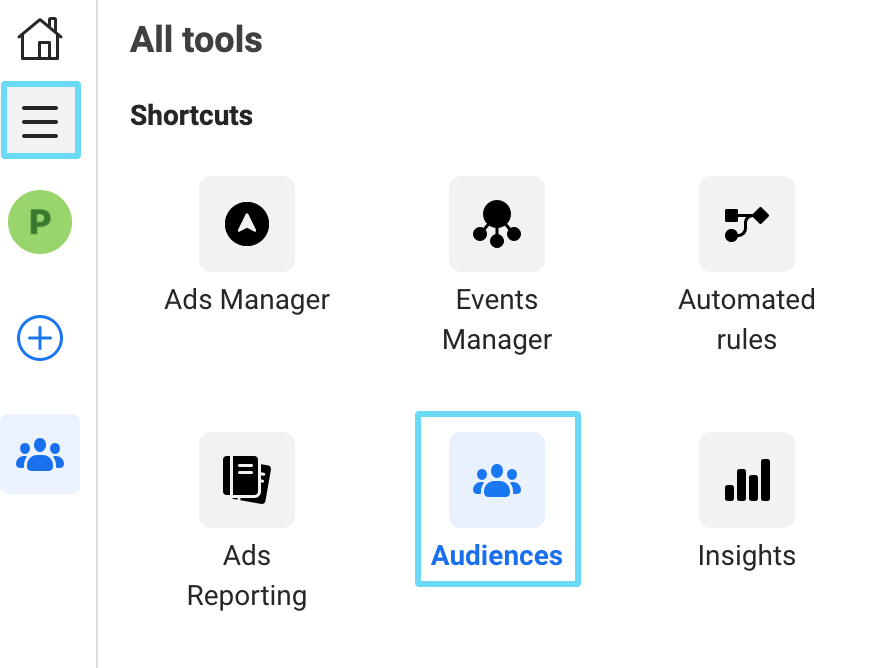
Finding “Audiences” under “All Tools”
- Then, to create a custom audience, click the “Create Audience” dropdown menu at the top and select “Custom Audience.”
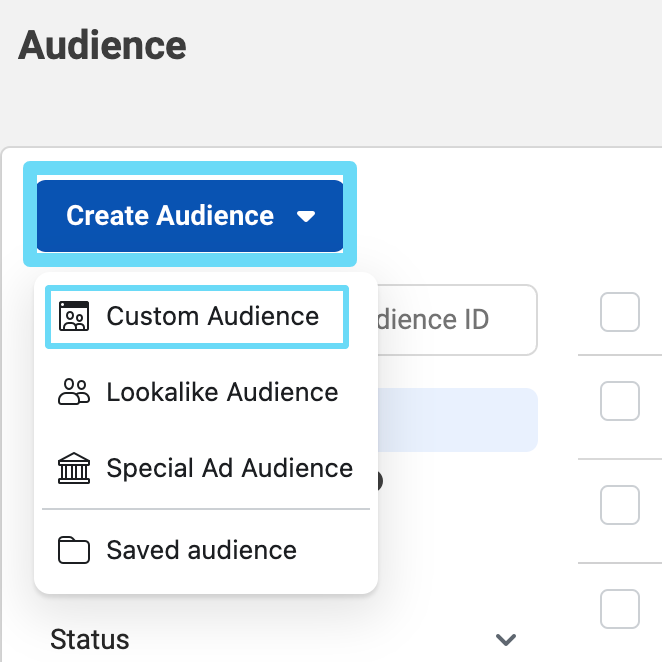
- You’ll be asked to select which type of custom audience you want to make, which we’ll go over next.
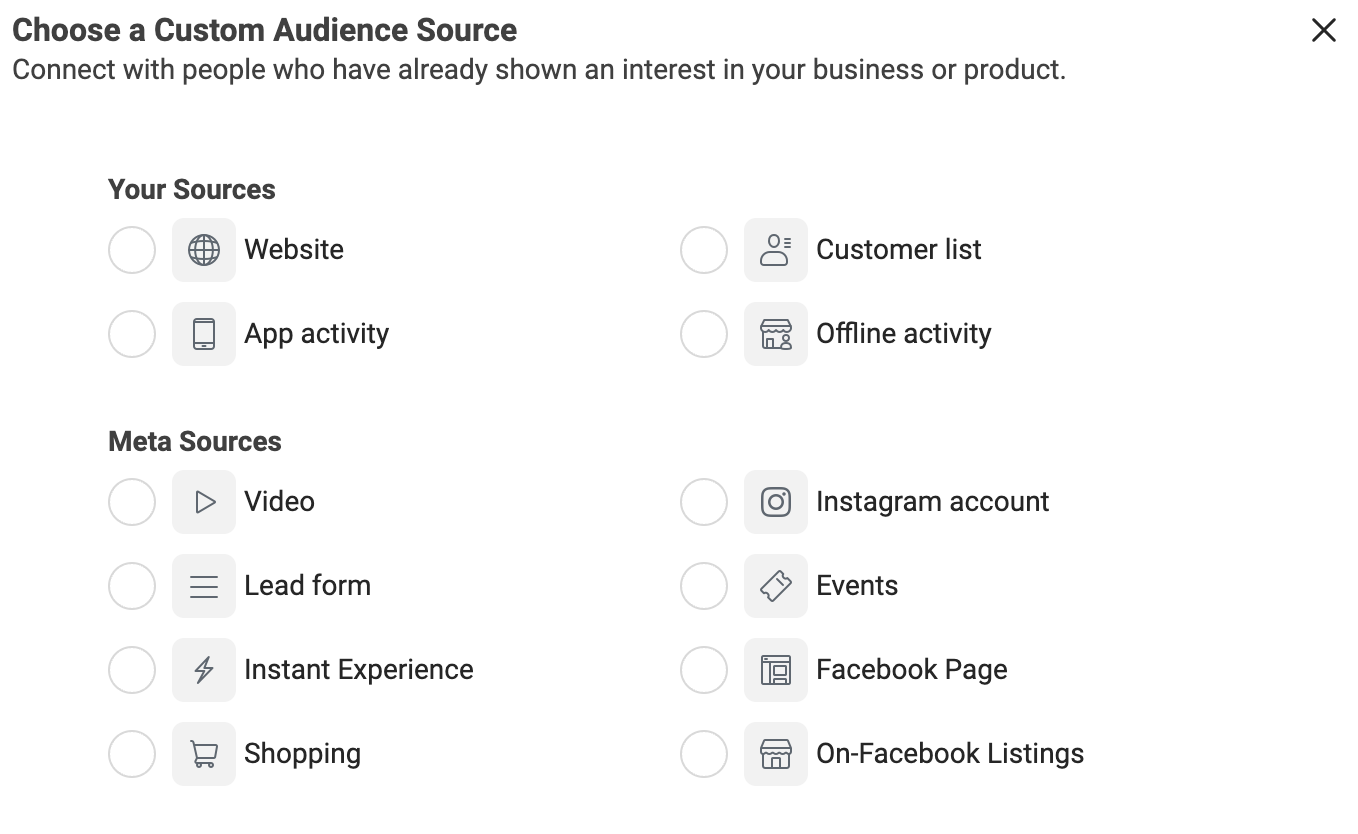
Types of custom audiences
The easy thing about custom audiences is that there are only two different categories. Within those categories, you have a handful more audience options to choose from that we’ll cover here.
On a basic level, your audiences can be built using your sources or Facebook sources.
Your sources
Your sources audiences are built using data collected about users outside of Facebook. This data may be collected using your Facebook pixel if you’re using the “Website” type of custom audience. Or, you may be targeting an uploaded customer list, offline activities, or activity from your app.

Facebook sources
Audiences created with Facebook (now called Meta) sources use data collected from users’ behaviors and engagements that happened on Facebook. For example, people who liked or followed your Facebook page.
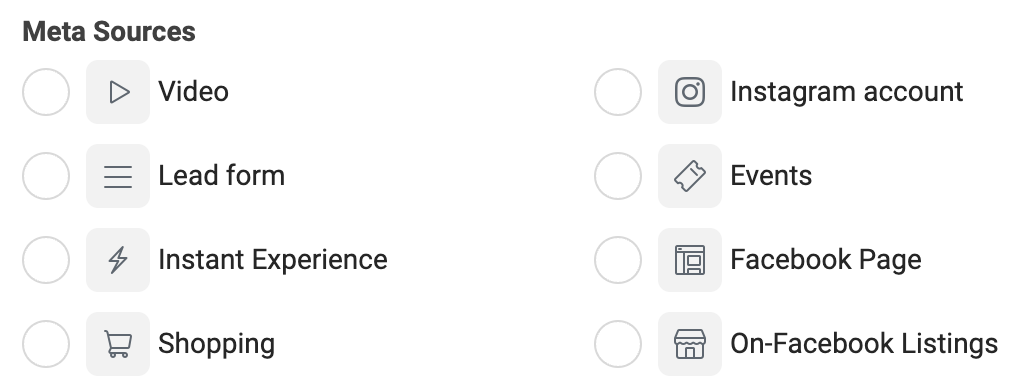
Why does Facebook custom audience targeting work so well? (2 key benefits)
If you’ve tried any other type of audience targeting, whether it’s lookalikes or interest audiences, you may have noticed that those audiences don’t bring in many high-value conversions. That makes sense, because the traffic temperatures of those audiences are typically cold.
What’s different about custom audiences is that their traffic is warm, sometimes even hot, because people in these audiences already know your brand and products. And where does a warm-to-hot audience sit within your funnel? At the bottom, where high-value conversions happen.
Let’s take a deeper look at the key benefits that make custom audiences work so well for your conversion rates.
Warm-to-hot traffic means more intent
No matter what custom audience you decide to target, all custom audiences target people who have seen or interacted with your brand before, one way or another.
In PPC traffic temperature terms, they’re a warmer audience, which means they show more actual conversion intent.
Someone who has been to your website before to view your products may already have you in the running for their final purchase decision. Someone who has liked your Facebook page is familiar with your brand and likes what you do.
Targeting these audiences gives you a higher chance of getting high-value conversions out of more people, which is excellent for your return on investment (ROI).
You’re picking up loose ends
Targeting custom audiences allows you to bring back opportunities you may have otherwise lost.
When you target custom audiences, you’re effectively intervening in their journey across the web. You’re reminding them of your product, its benefits, and showing them a warmer offer that they’re probably more interested in now than they were on their first visit.
Take this for example: Someone who’s exploring your brand for the first time probably isn’t going to capitalize on a “15% off your first purchase” offer. They might not even take you up on a free demo. Both those offers are pretty threatening to a newcomer.
However, after they’ve gotten to know your brand and product better, and have shopped around at some of your competitors, they’re much closer to a sale–so that 15% off is going to start looking better and better to them.
Before you start, don’t neglect your top of funnel audiences
I’m sure all of this talk of warmer audiences and higher intent sounds amazing. It may even sound like custom audiences are the only types of audience you want to target.
I’m going to stop you right there.
At KlientBoost, we’re all huge fans of a balanced funnel.
And a balanced funnel is actually a lot more heavily skewed toward top-of-funnel audiences, believe it or not. We aim to spend at least 70% of our total monthly budgets on the top of the funnel. If you think that sounds ridiculous, hear me out.
Prospecting audiences (your most top-of-funnel audiences) are the cold customers, the ones who don’t really know your brand yet and might be trying to warm up to you. These could be detailed targeting audiences or lookalike audiences.
I’ve rarely ever met a client who was fully on-board with prospecting, because to many of them, it seems like they’re just wasting money on an audience that’s not giving you what you want.
Not true, actually.
Prospecting is your means to a successful retargeting strategy. And an overall successful Facebook advertising strategy isn’t complete without both.
Think of it this way: You know what feeds that retargeting goldmine and keeps it producing? Prospecting.
Prospecting top-of-funnel audiences brings new potential customers to your site in droves, and it increases the amount of people you can nurture toward a conversion with retargeting.
It’s the circle of life…Facebook style.
We spend a lot of our budget on prospecting here because it keeps our retargeting lists fat with audience members. This increases the amount of people in that audience that are ready to convert, which gets us more bang for less buck.
So, don’t forget about your prospecting audiences. Use prospecting and bottom of funnel audiences together in the right balance, and you’ll have it made.
Creating Facebook custom audiences using your (non-Facebook) sources
Most businesses have more useful targeting data than they realize. This data might come from how people interact with a business’s website, like a page view, or it might come from information that people have given out, like their email address.
Both of these types of data and more are targetable with custom audiences built from the “Your Sources” option. And arguably, “Your Sources” audiences are the most valuable of the two custom audience types.
We’ll help you understand the specifics of creating custom audiences from your sources, so you can start testing them faster.
Website traffic
Likely one of the most useful and popular options, custom audiences built from your website traffic, use the Facebook pixel installed on your website to add members to your audience lists.
If you haven’t installed your Facebook pixel yet, head here to learn how to get that started. It’s a must in order to set up this type of audience (and it’s essential for proper conversion tracking, too).
Website traffic audiences can add people to audience lists who visited your website, or who completed certain events you’ve set up, all using the data your Facebook pixel stores. So, this is where those goldmine retargeting audiences are made.
To set up a website traffic custom audience, follow those initial steps. To recap, go to audiences, click the “Create Audience” dropdown, then select “Custom Audience.”
Select “Website” as your custom audience type, and click “Next.”
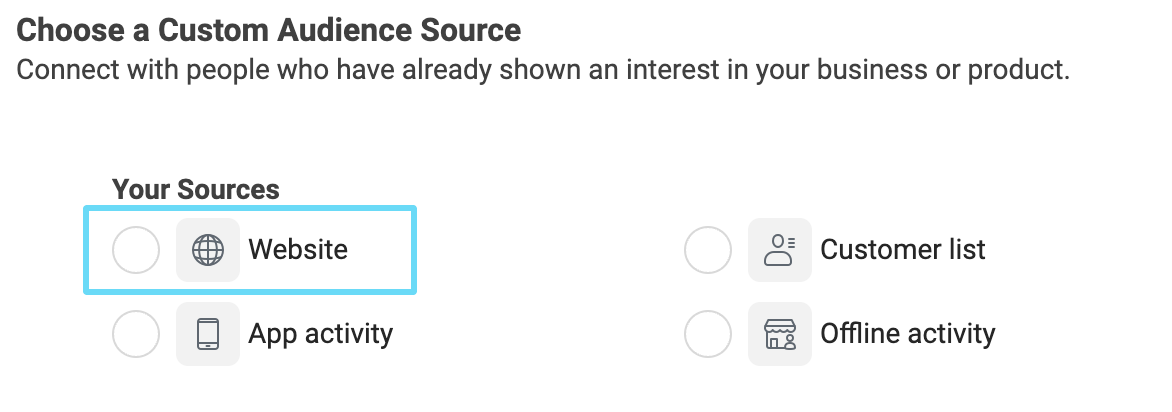
You’ll see a setup screen now, with all the details to set up your audience.
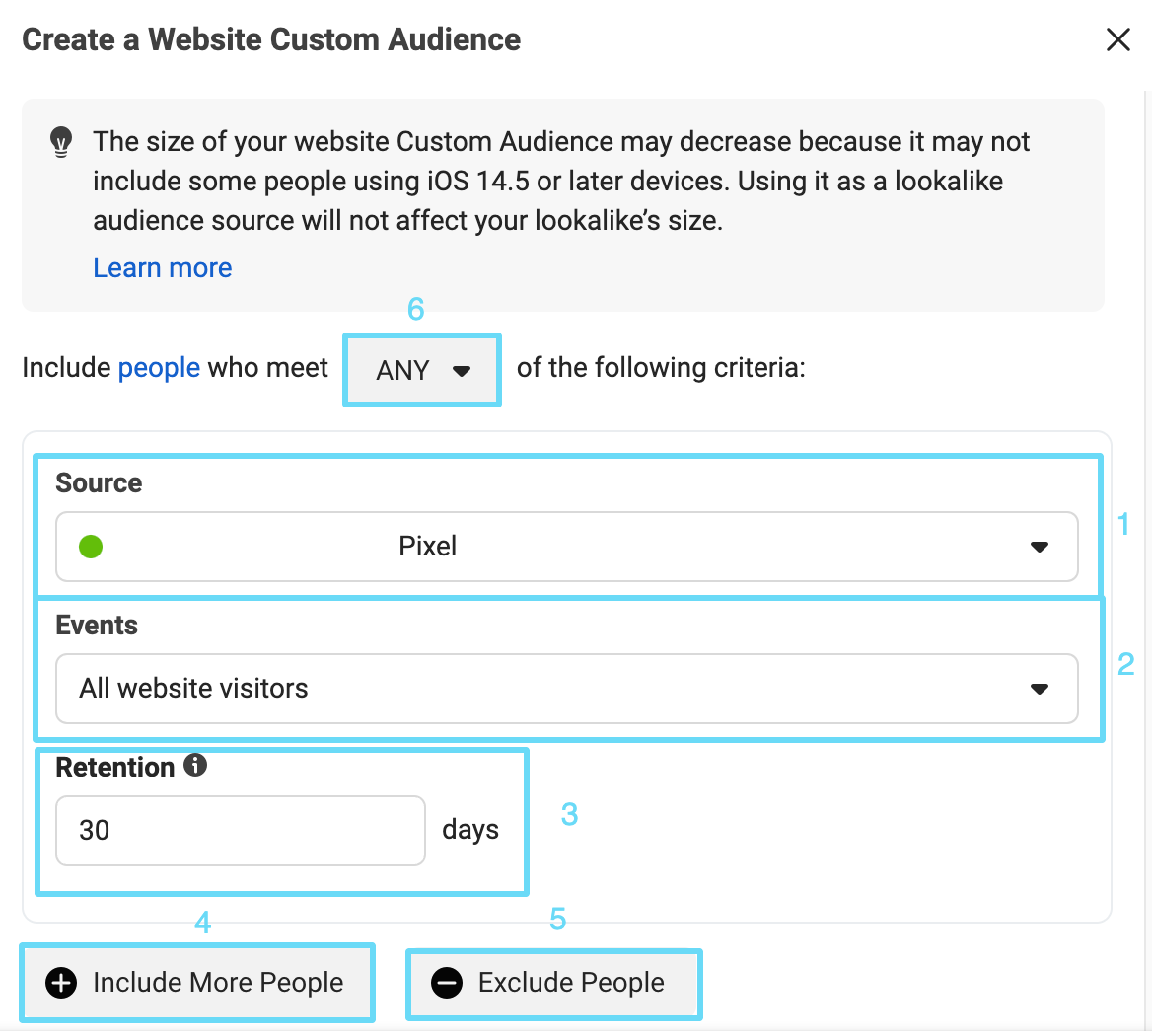
Let’s look in more detail at the settings we’ve boxed and numbered in the screenshot above:
- Source: Select the pixel you’ve installed on your website.
- Events: Select who you want to add to this audience based on actions they’ve taken on your site. You can choose from all website visitors, visitors of only certain pages on your site, visitors by time spent on your site, or people who have completed your conversion events.
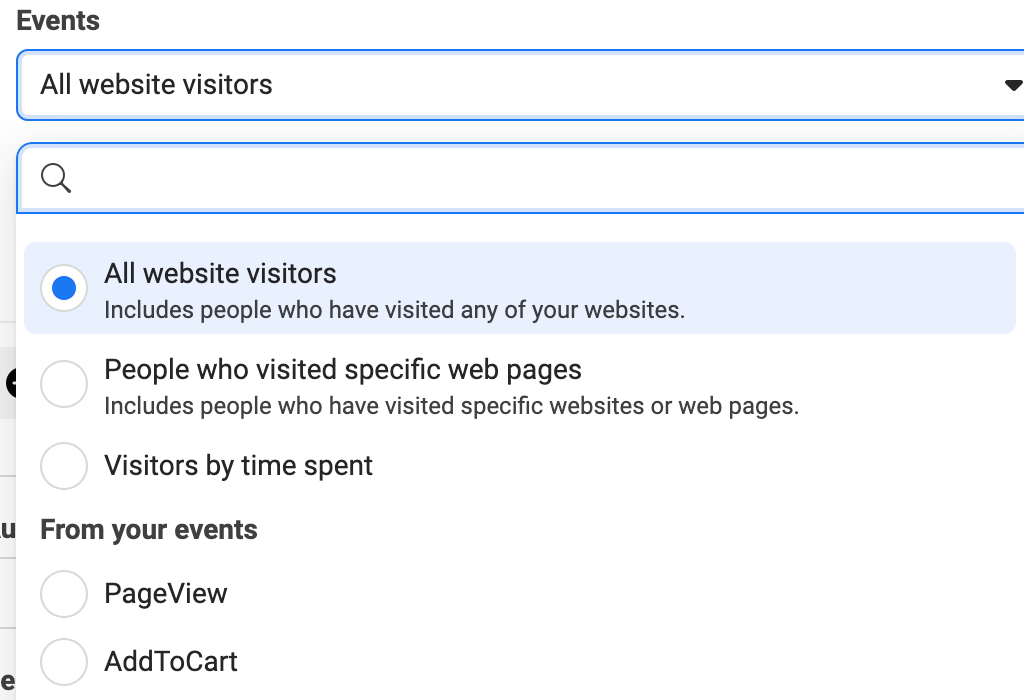
- Retention: Decide how long someone stays in this audience. (You’ll set a retention window for all event types.) 30 days is typical because you’re still fresh on the mind in that window, but 90 days is usually the max. People who visited your site 180 days ago are likely uninterested.
- Include more people: Decide if you want to refine or add to your audience. For example, you might decide to target all website visitors, then add another criteria of people who completed your newsletter signup event, etc.
- Exclude people: Decide if there’s anyone you want to exclude from this audience. For example, you might target all website visitors, but decide to exclude anyone who’s already completed a conversion event.
- ANY or ALL: This refers to the relationship between your first audience and any added audiences. For example, say you’re targeting all website visitors and people who completed your newsletter signup event. If you select “Any,” you’re saying you want to target people who meet one or the other of these criteria. If you select “All,” you’re saying you want to target people who meet both of those criteria.
That’s it for the basic setup of a website custom audience, but for a more detailed look at website retargeting, head here to learn more.
Customer lists
Customer list custom audiences allow you to upload spreadsheets containing customer data into Facebook. Once uploaded, Facebook will then try to match the information you’ve provided with the Facebook accounts of those specific contacts.
If the list of matched contacts is large enough, you can then use that audience to show ads to those specific people. They may have missed your calls, or maybe all your emails went to their spam folder–but showing ads to them is a whole new way to revitalize their interest again, especially if those ads contain a juicy offer.
Remember, in terms of traffic temperature, these leads may be warm or hot prospects. They’ve already given you their contact info, so now’s the time to try to seal the deal with a warmer offer.
One of our clients, for example, was able to increase the ROAS of their campaign by 4.51 overall after adding a customer list adset to the campaign.
For another one of our clients, look at how much lower their CPA was when using a customer list (of past free trial users) compared to general retargeting:

Although the conversion volume hadn’t built up yet for our customer list, we were already seeing 124% lower CPA to that audience than general retargeting–that was about to be a much more profitable audience for us.
To create an audience from a customer list:
- Select “Customer List” this time in custom audience creation.

- Decide if you’d like to import a contact list from Mailchimp, or import a TXT or CSV file you have. If you want to import a spreadsheet, then you don’t need to click anything on this page–just click “Next.”
(Note: If you’re not sure how your list needs to be formatted for a seamless upload, you can click the “download file template” button and/or the “see formatting guidelines” button.)
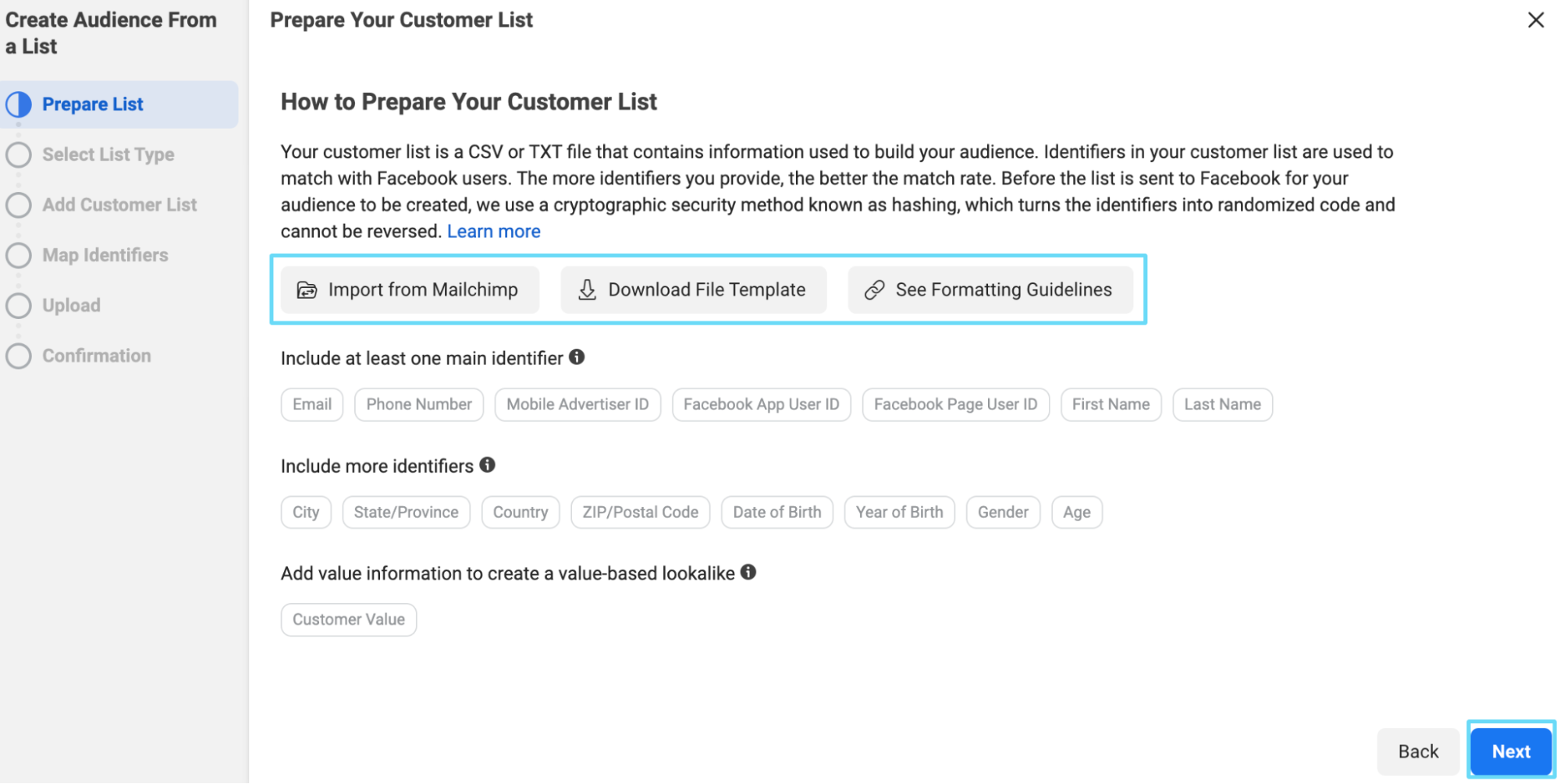
- Select whether or not your customer list contains a column for customer value. This might be the amount a customer has spent in the past. If your customers don’t have a value, or it’s not important, click “No.” You also need to accept the Custom Audiences Terms at this stage before you proceed.
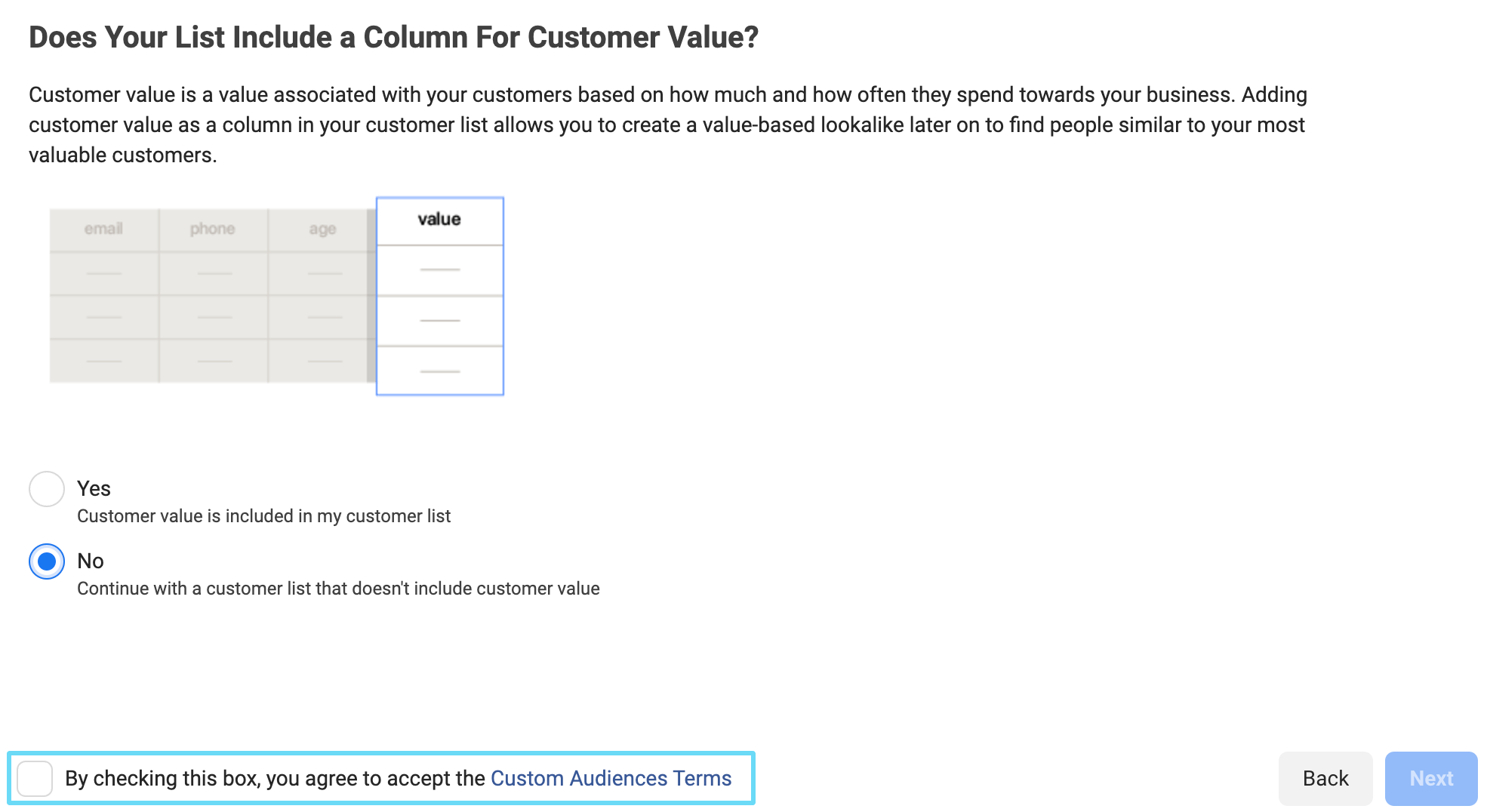
- Now, upload your properly formatted customer list. Make sure your list contains at least one main identifier (although the more you include, the better, because it may help improve your match rate). We usually try to have at least the first name, last name, and email. You’ll also need to name your list at this stage.
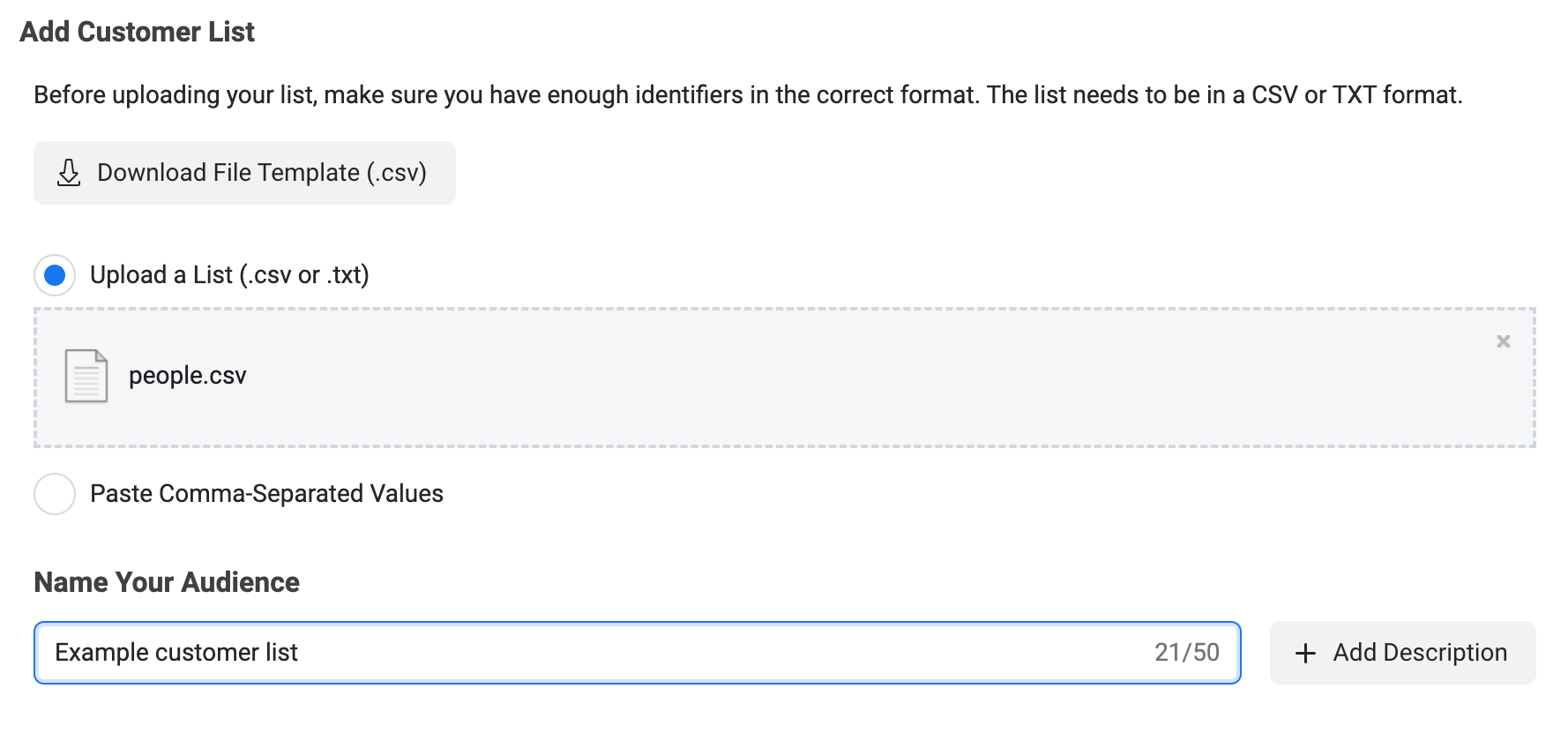
5. Map out the columns on your spreadsheet if Facebook hasn’t already mapped them correctly. Essentially, you’re telling Facebook that you want your “First Name” column identified as first names and so on.

For any identifiers you see that are incorrectly mapped:
- click on the drop-down menu that says what they’re matched as now
- select the correct identifier if you still want to upload that data
- select “Do Not Upload” if you don’t want to upload that data
For any identifiers that Facebook hasn’t mapped:
- go to the “Action Needed” tab
- find the identifiers you want to map
- click the drop-down menu that says “Do Not Upload” and instead select what you want the data mapped as
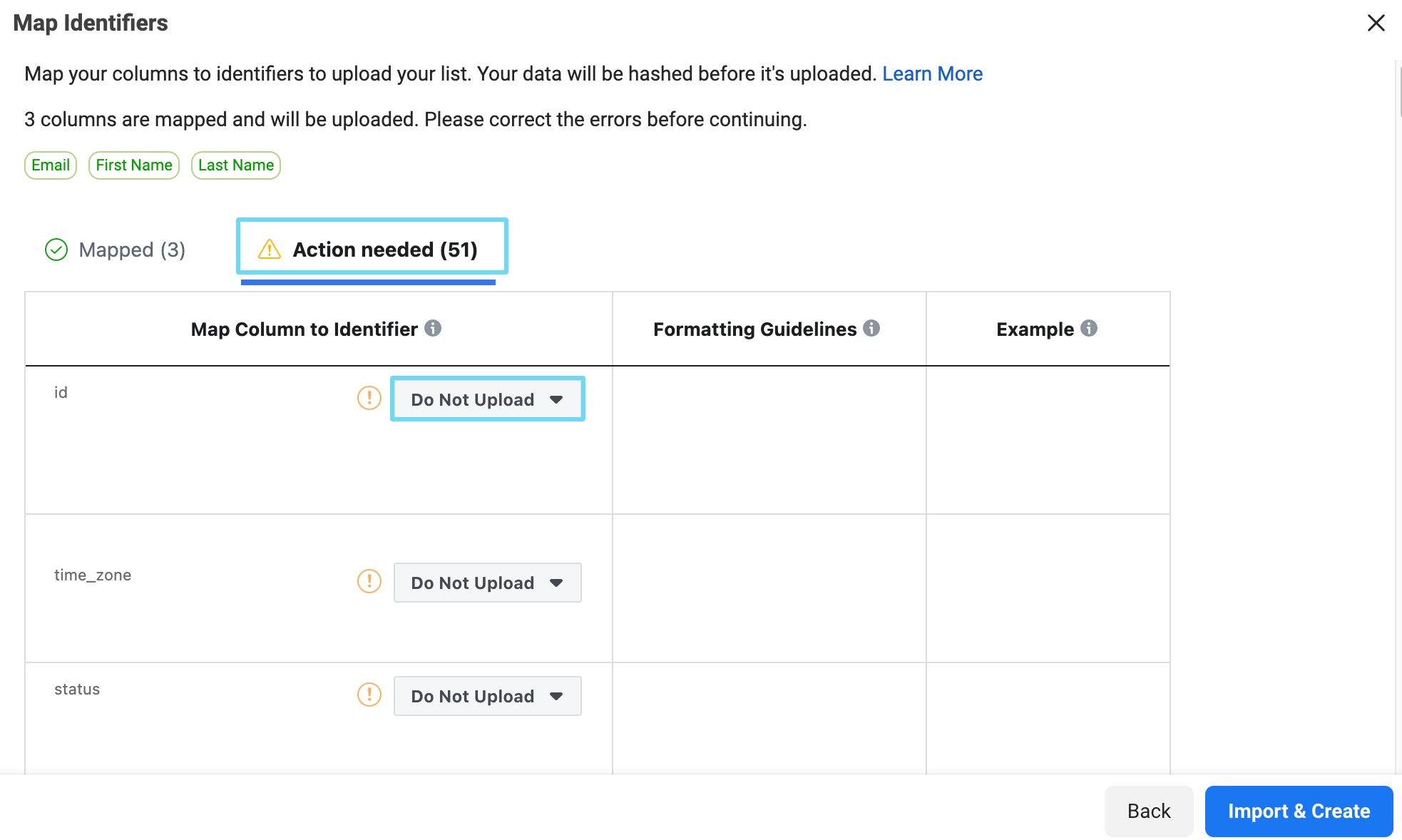
Once you’ve mapped everything you wanted to, click “Import & Create.”
Pro tip: You don’t have to map all identifiers on your sheet if you don’t want to, which means you don’t need to resolve everything under the “Action needed” tab (the name can be deceiving). Just map what you want, leave the rest of the “Action needed” items as they are, and import your list.
6. Facebook will process the upload of your list, then show you a confirmation. After that, it’ll take a bit for your list to populate with matched data. Give it around an hour and check back to see what the audience size looks like.
Good to know: Your customer list audience will likely be small; that’s expected. Ideally, you should aim for a list that has over 2,000 people on it (the bigger the better). You can still target a list under 2,000 members (even if Facebook claims it’s too small to target). The smaller your list gets, however, the more difficult it will be to get cost-effective results from it.
Offline activity
While Facebook can track anything that happens online (i.e., on your website that your pixel can track, or within Facebook itself), it doesn’t have any idea about what’s happening offline.
So it doesn’t know when you’ve marked a lead as qualified or disqualified in your customer relationship management system (CRM), or when you’ve closed a sale over the phone, etc. If you’re in eCommerce, Facebook also won’t know when someone who saw your ad then made a purchase in your brick-and-mortar store.
But if you’ve already set up offline conversion tracking to pull in offline events and data, then you can create a list based on those, too.
For example, let’s say you’ve imported your successful sales that resulted from leads (offline events), and want to serve those people ads promoting a related service. You can make an audience out of that offline event.
To set up an offline activity custom audience:
- Select “Offline activity” this time when creating a custom audience.

- Choose the source and the event you want to build your audience from. (Remember, offline sources must be set up separately.) For the event, since we want to track events that have happened offline, we’ll select “People who interacted offline.”
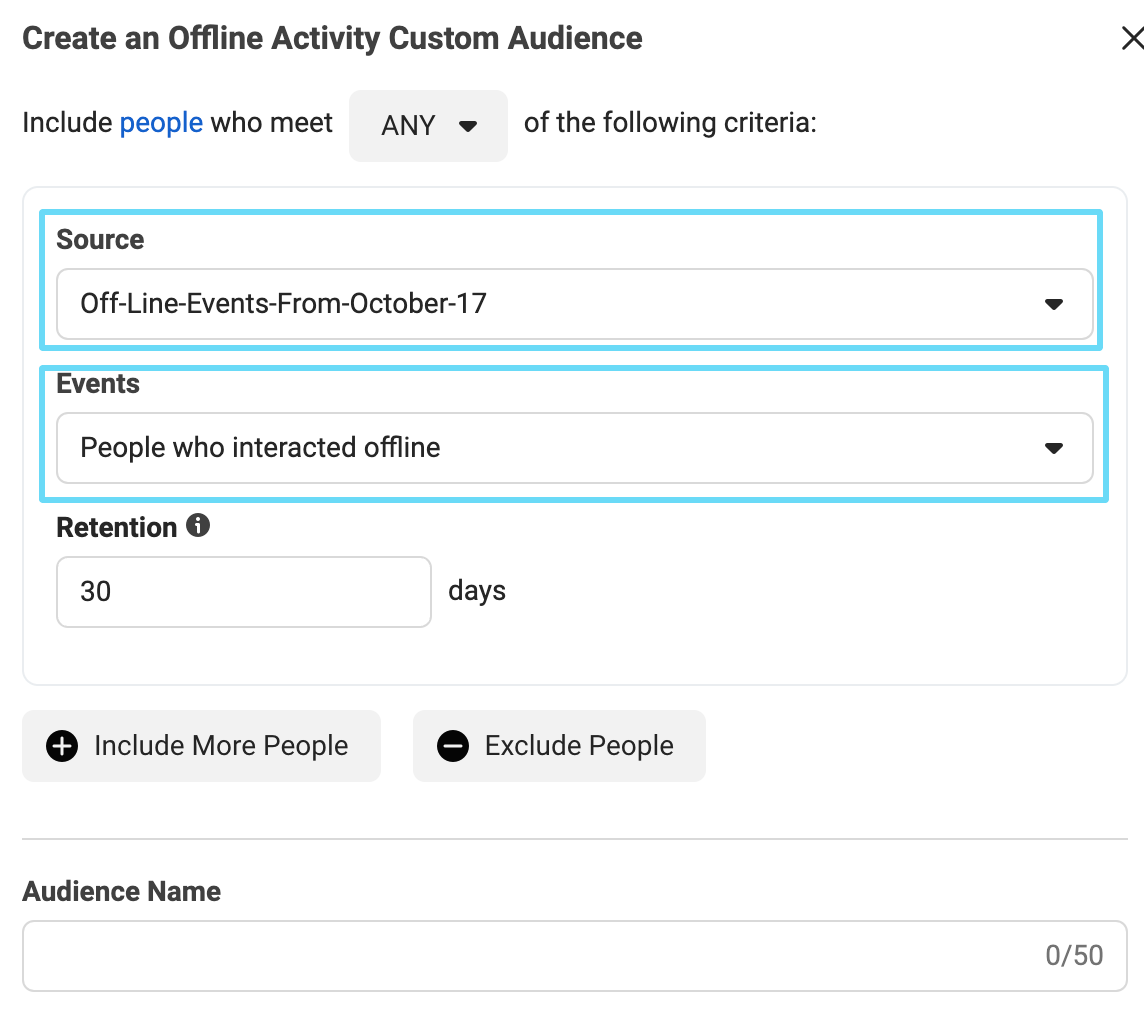
5. Set your desired retention window, refine your audience if needed, name your audience, and you’re good to go.
App activity
If you have an iOS or Android app, you can target people based on the actions they take in your mobile app. This can be especially useful if many of your purchases happen through an app you own.
To set up a custom audience based on app activity:
1. First, you’ll need to register your app, set up Facebook’s SDK, and set up app events to reach specific users.
2. When you’re ready to create your audience, select “App activity” in custom audience creation.

3. Name your audience and select the app you want to create your Custom Audience from.
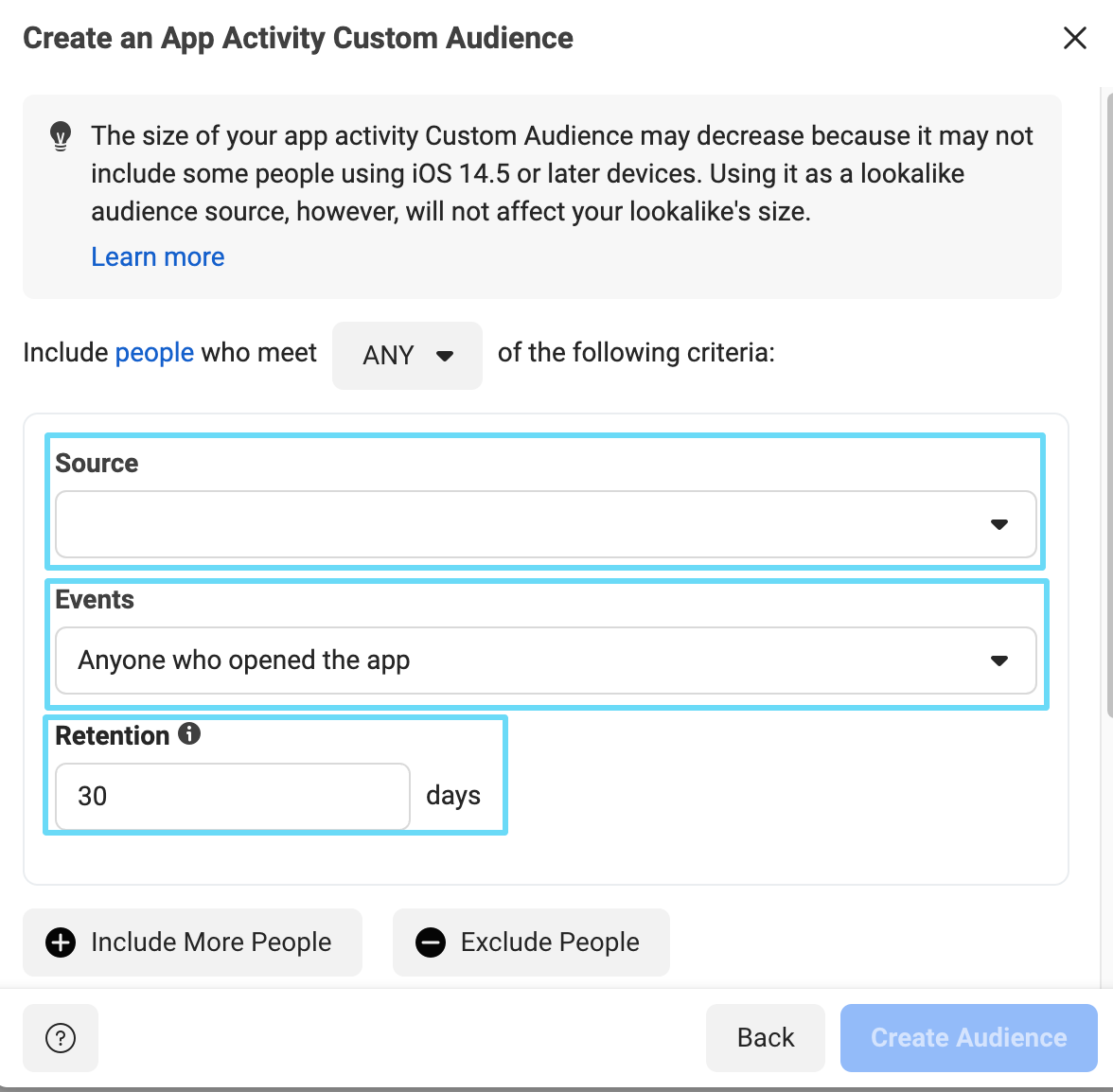
4. Select which events you want to target.
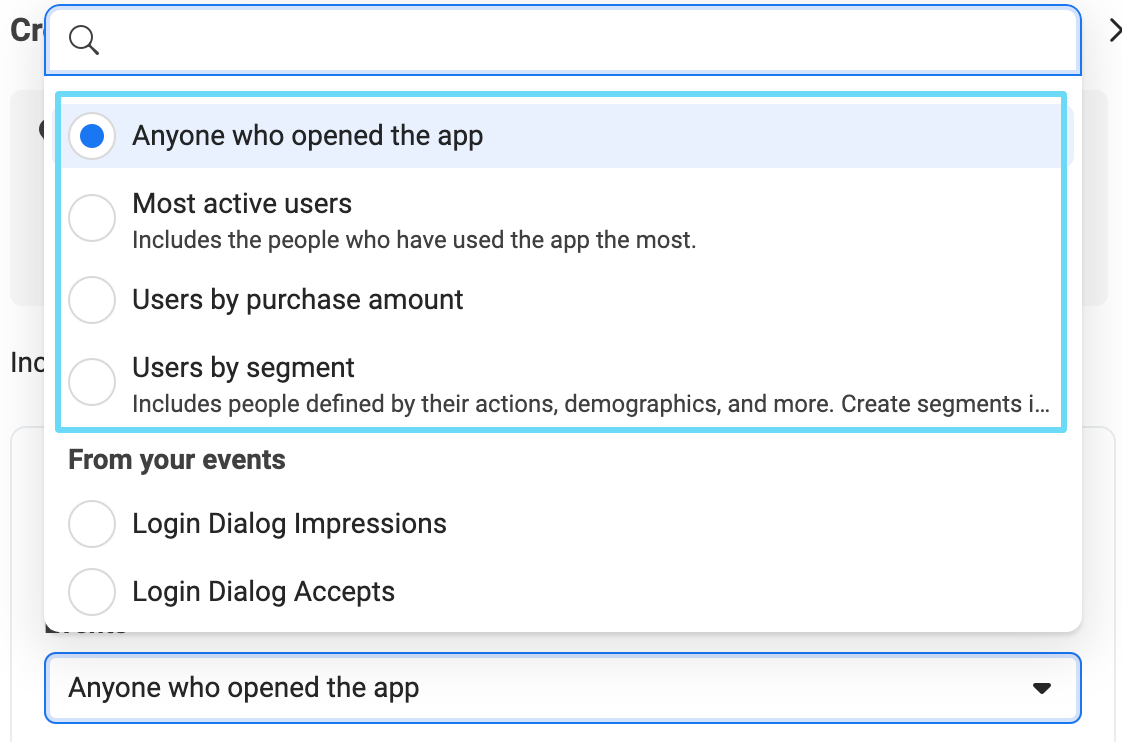
8. Select your retention window. Then refine your audience if needed, name your audience, and you’re all set.
Creating Facebook custom audiences using Facebook sources
One nifty little card Facebook has up its sleeve is the ability to track actions people have taken on the Facebook platform. You can use these tracked actions to create Facebook engagement custom audiences.
For example, do you have a lot of page likes? You can make an audience out of those. Have a lot of engagement on your Instagram page? You can make an audience out of those, too.
There’s a handful of audience targeting options you can choose from when it comes to Facebook sources, so we’ll give you a brief overview of each one.
To keep it focused, we won’t spend time covering setup elements that all other audiences share–like naming or refining your audience, or setting your retention window. Instead, we’ll cover the unique parts of setting up these specific audiences.
Video watchers
Video is easily becoming one of the best ways to engage with your audience on Facebook and Instagram alike. If you have a lot of video ads running, then you might want to retarget people who watched a certain amount of your video.
People who watched your video longer are likely to be higher intent prospects who are more interested in your product, and that could be the perfect audience to show a warmer offer to.
To get started, select “Video” when setting up your custom audience.

There’s only 1 setup element here that’s different from the setup parts all audiences share, and that’s “Engagement.”
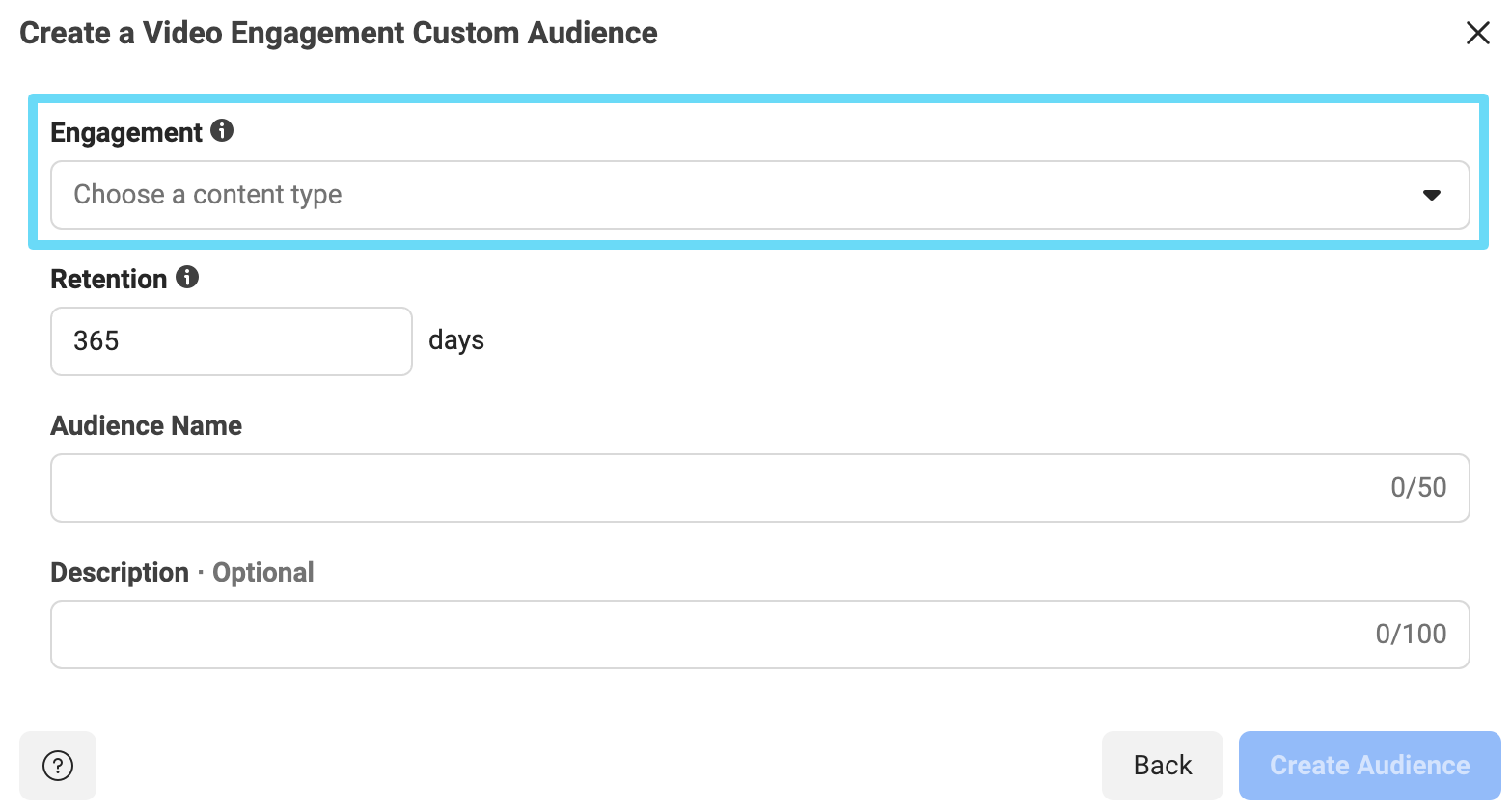
Engagement refers to the level of video engagement (expressed as a percentage or seconds watched) you want to target. You’ve got a lot of options, but it’s likely that people who watched 75 - 95% of your video are more interested in your product.
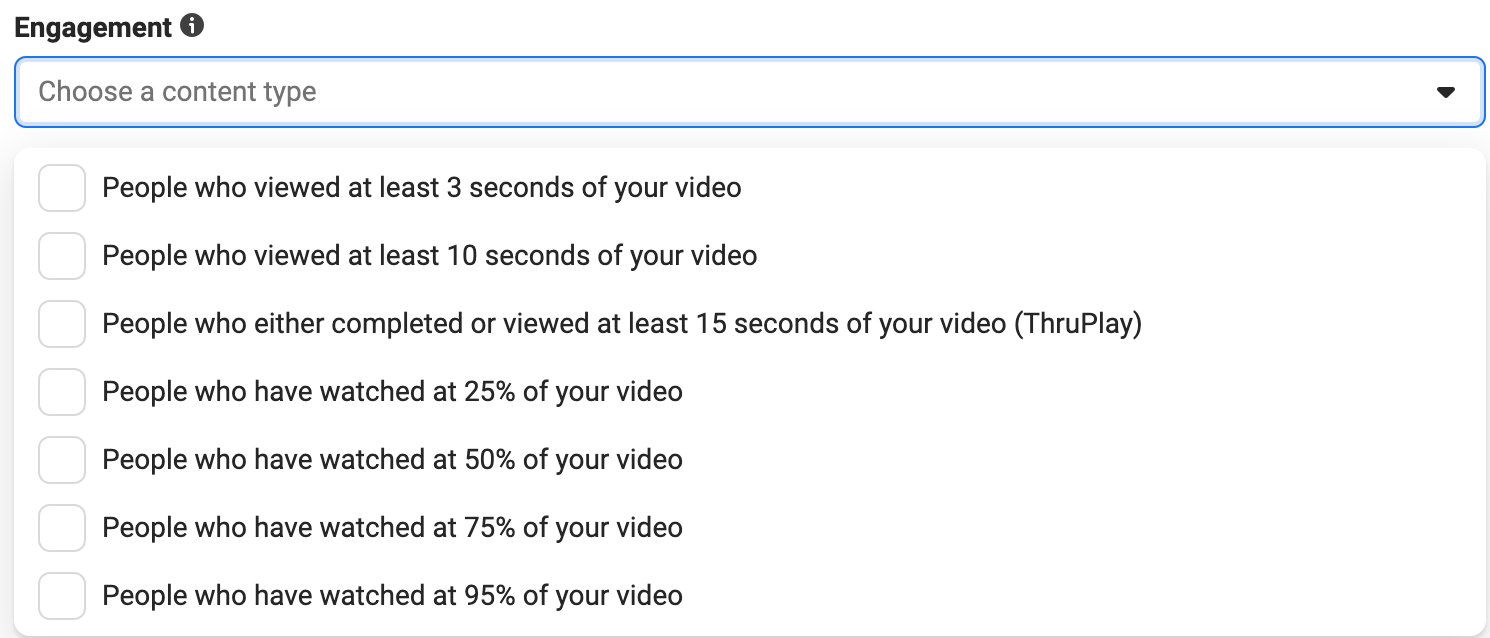
Pretty easy. Now once you’ve set your retention and named your audience, it’s good to go.
Lead forms
If you’re using on-Facebook lead ads, meaning your ad itself contains a lead form (rather than directing to your website to have a customer fill one out), then you can also make an audience out of people who either completed or opened your form.
To get started, select “Lead form” in custom audience creation.
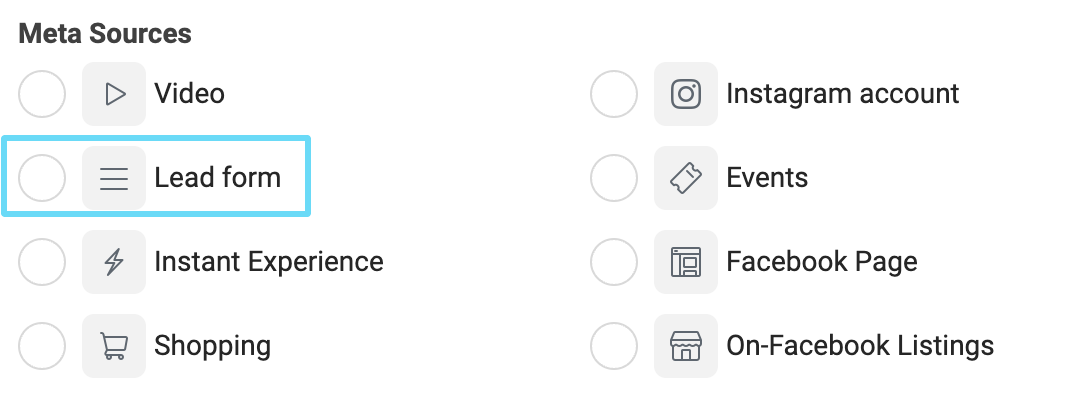
For this audience, there are 3 unique setup elements to pay attention to: “Events,” “Page,” and “Lead Form.”
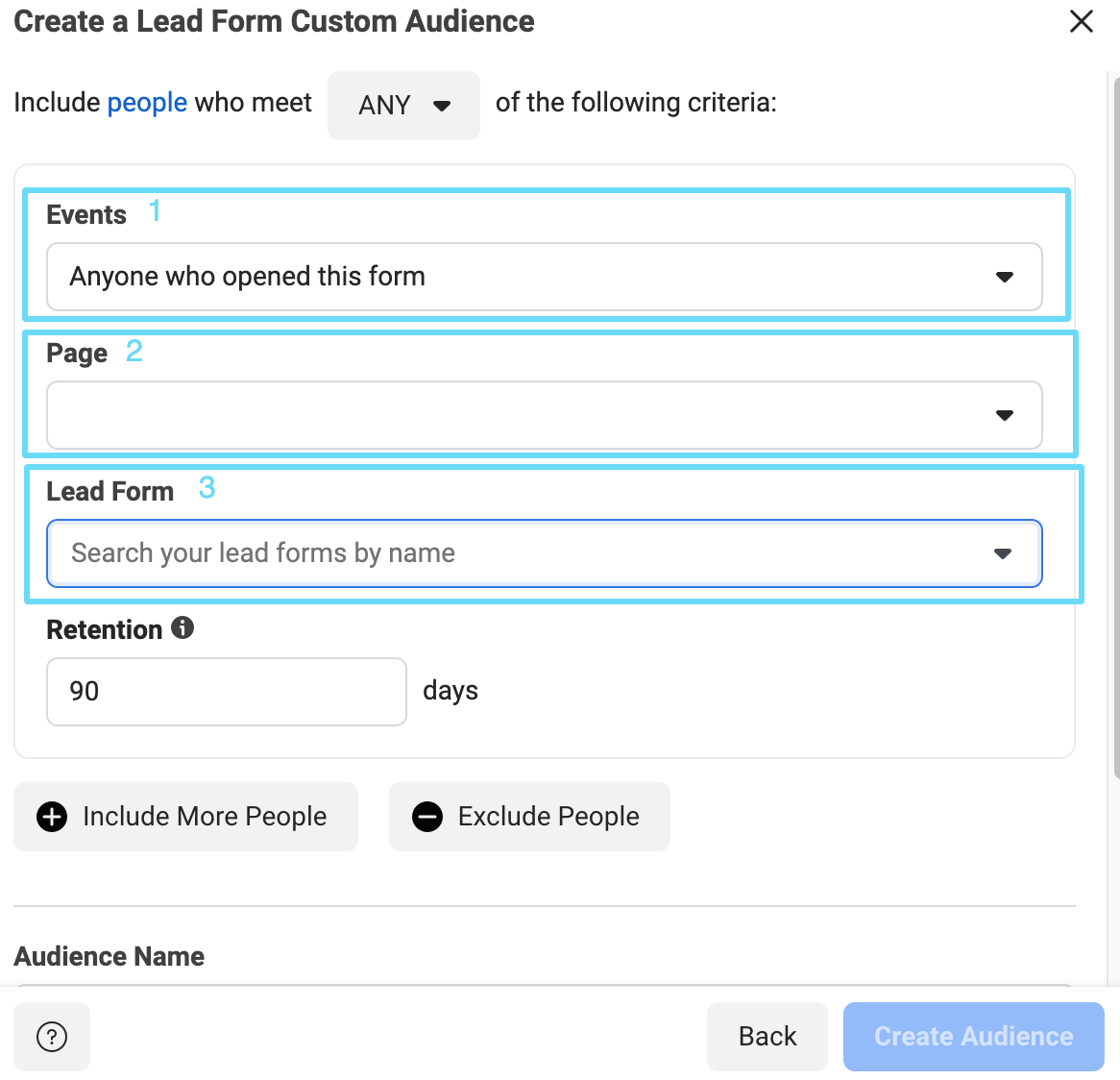
1. Events: Select which actions on your lead form people would need to take to be added to your audience.
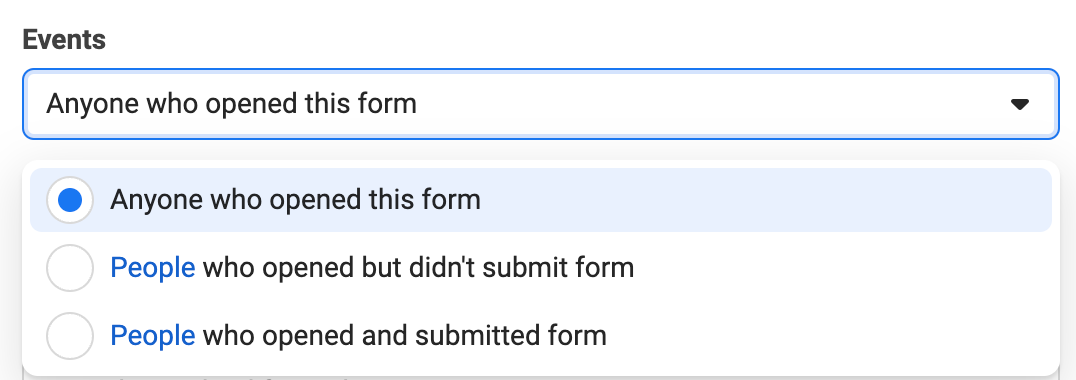
2. Page: Select the Facebook page your lead form was created under.
3. Lead form: Select the specific lead form you’re building this audience from. If you’ve already created and have been using a lead form, its name should be listed in the drop-down.
You're all set. Now, just wait for your audience to populate, and get started using it.
Instant Experience
Instant Experience ads give advertisers the chance to completely enwrap their audience in their products or services with full-screen scrollable visibility.
So, once someone has opened and spent time engaging with an Instant Experience, it stands to reason that they’d be good prospects to retarget.
If you already have an Instant Experience running, then you can get started by clicking “Instant Experience” in custom audience creation.
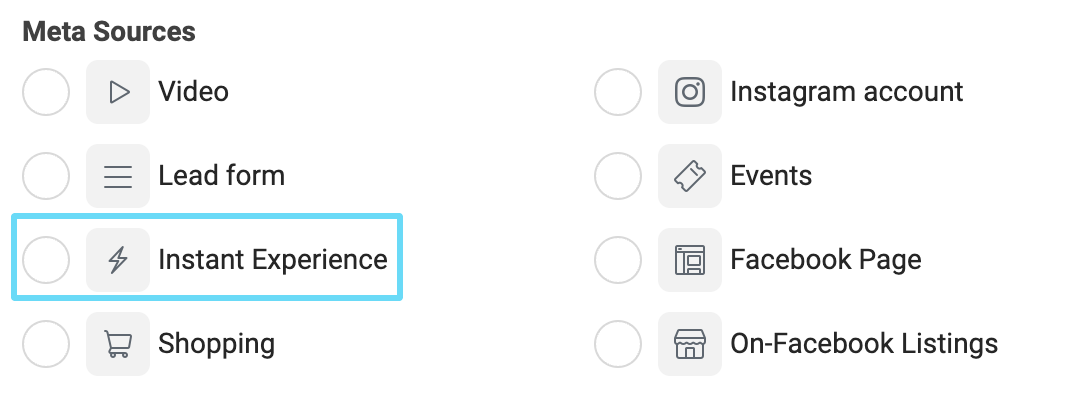
Instant experience audiences also have 3 unique points to set up:
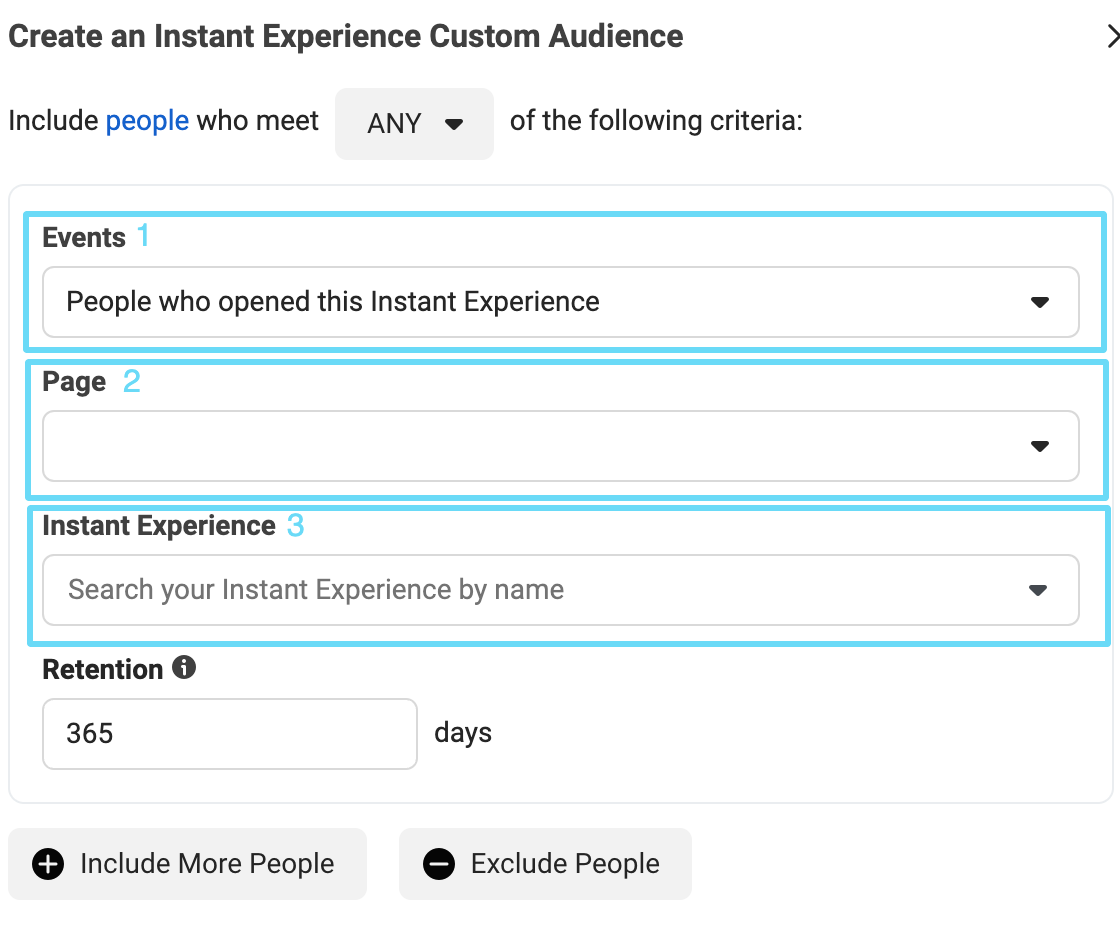
- Events: Decide whether people who opened or people who clicked links in your Instant Experience should be added to your audience.

- Page: Select the Facebook page associated with your Instant Experience.
- Instant Experience: Search for the Instant Experience you want to collect audience members from.
And you’re good to go.
Shopping
If you’ve set up a shopping experience on Facebook and Instagram, people can browse specific products in a storefront style, and even buy them there without needing to migrate to your website.
Like you would want to if they were shopping on your website, you can also retarget people who completed certain actions in your Facebook or Instagram shop. For example, people who added items to their shopping carts.
To get started, select “Shopping” from custom audience creation.
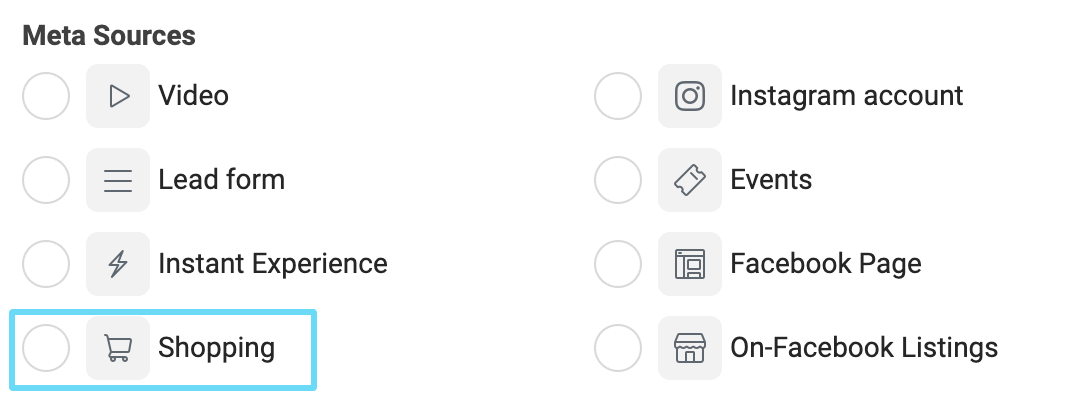
Then, have a look at the 3 unique setup options for a shopping audience:
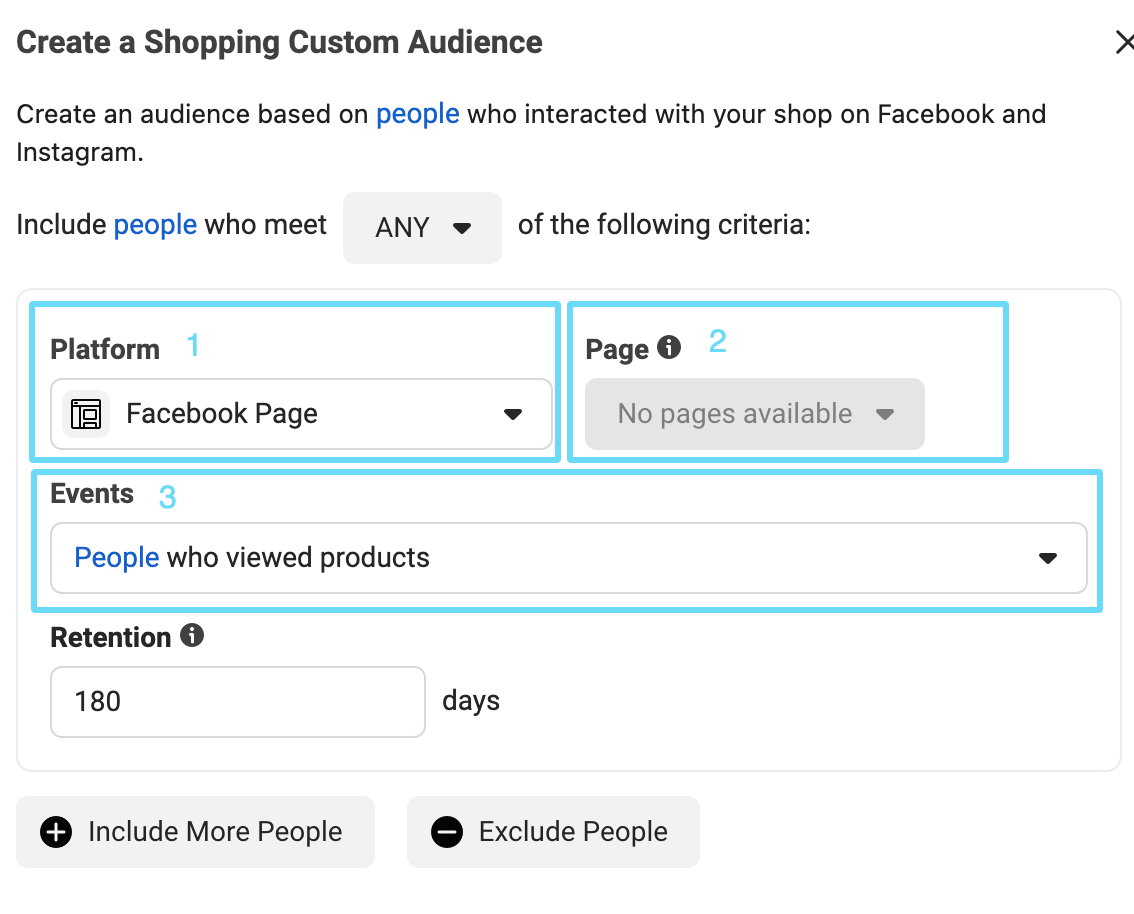
- Platform: Select whether you’re adding people to this audience from your Facebook page or your Instagram page.
- Page: Choose the page your shopping experience is associated with.
- Events: Choose when people are added to your audience based on what action they’ve completed in your shop.
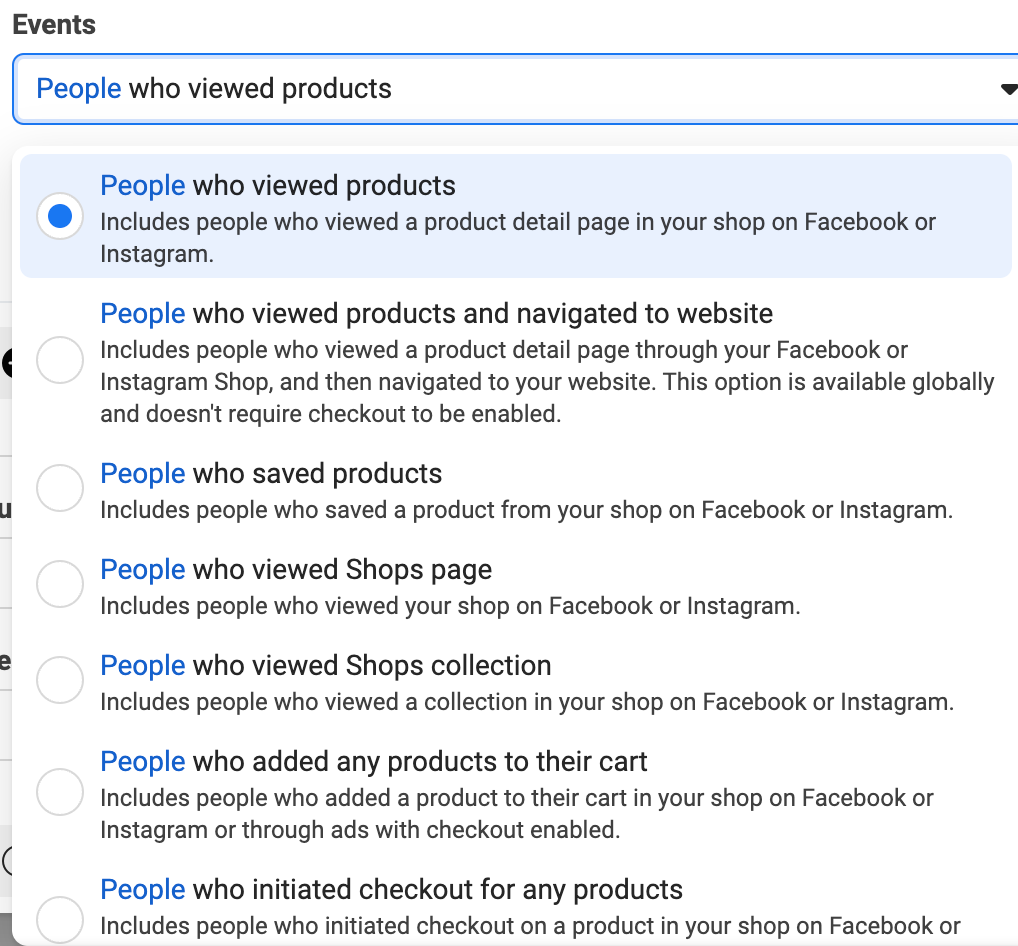
Instagram account
Have a creator or business account on Instagram? If you receive a lot of engagement there, this is your chance to retarget people based on actions they took on your Instagram.
To start building this audience, select “Instagram account” in custom audience creation.
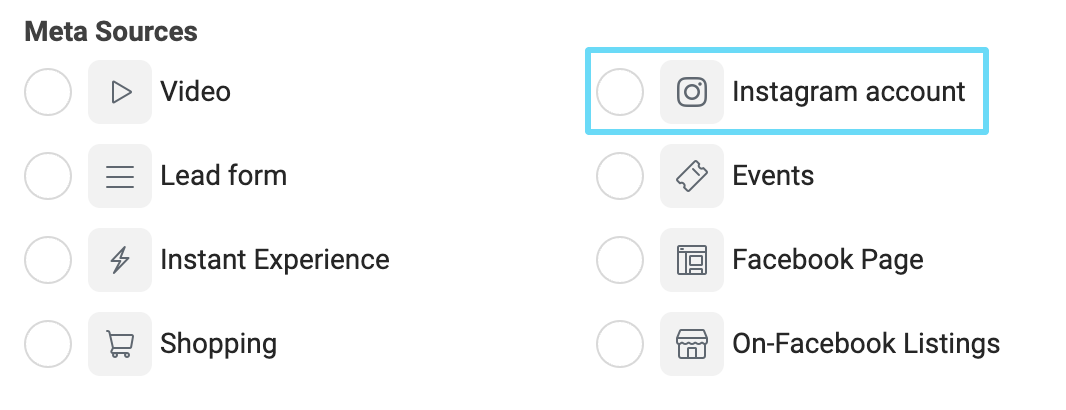
To set up your audience, there are just 2 unique setup options to look at aside from those settings that are standard across audiences:
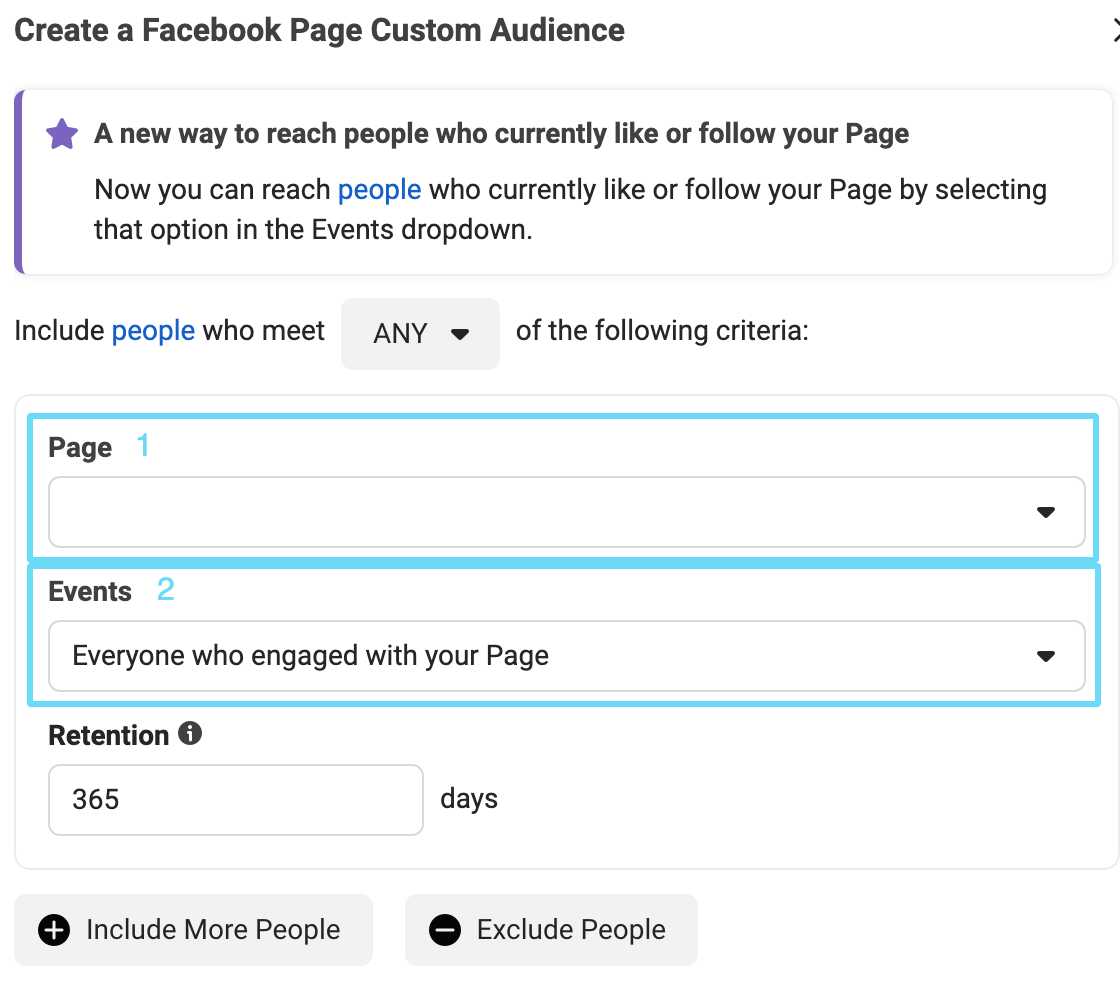
- Source: Select the Instagram account you want to pull audience members from.
- Events: Select the action people have to take on your Instagram account in order to be added to your audience.
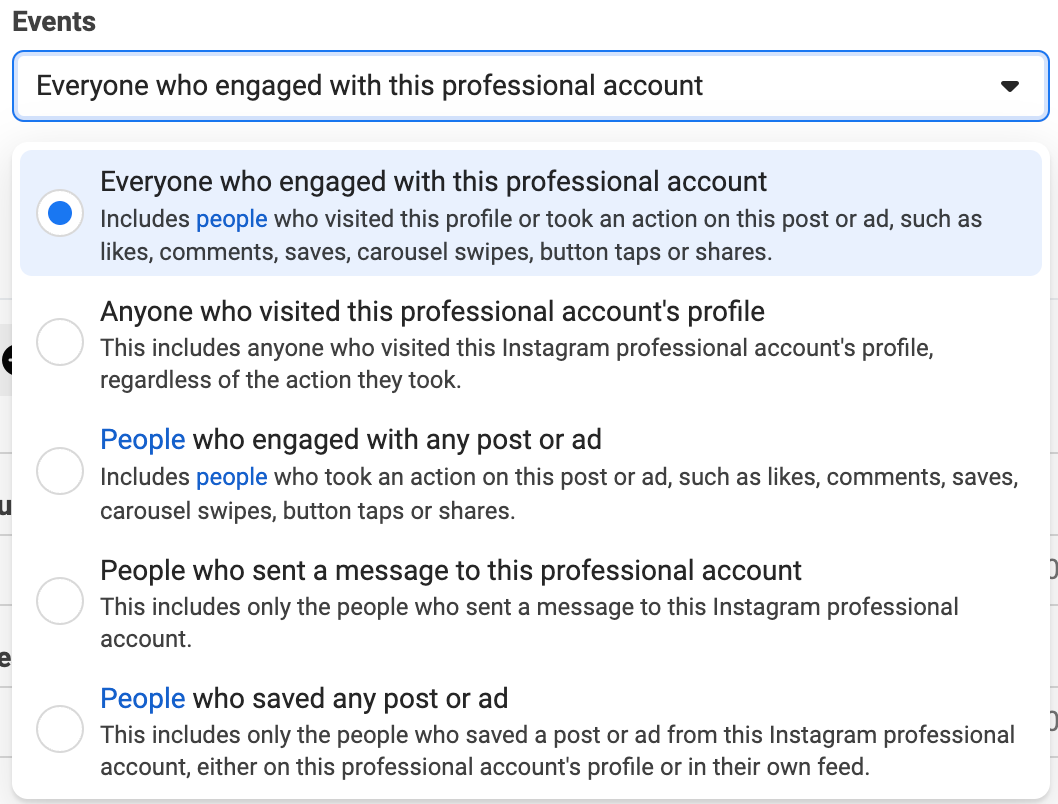
Now you can start making use of all the ways people engage with your Instagram account.
Events
Advertising an event on Facebook presents people with lots of opportunities to engage. These can also make useful retargeting audiences, especially if you’re trying to drum up an audience for new events regularly.
To make these audiences, click “Events” in custom audience creation.
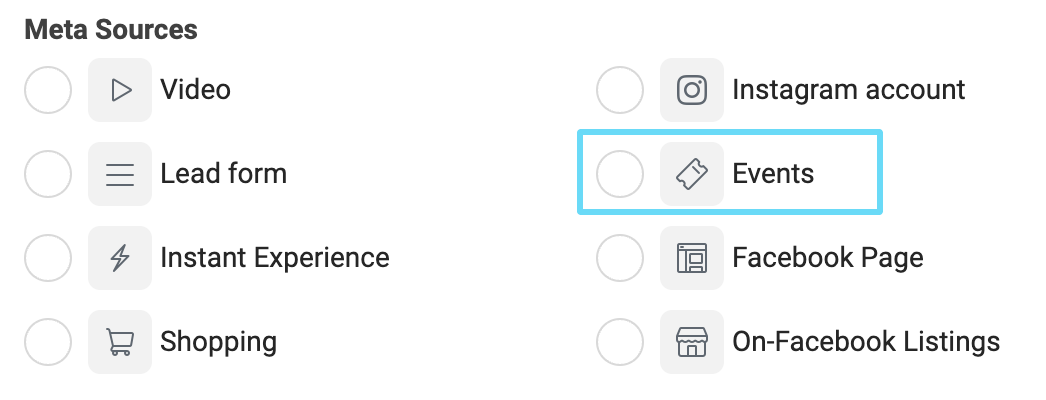
There are 3 unique setup elements to pay attention to here:
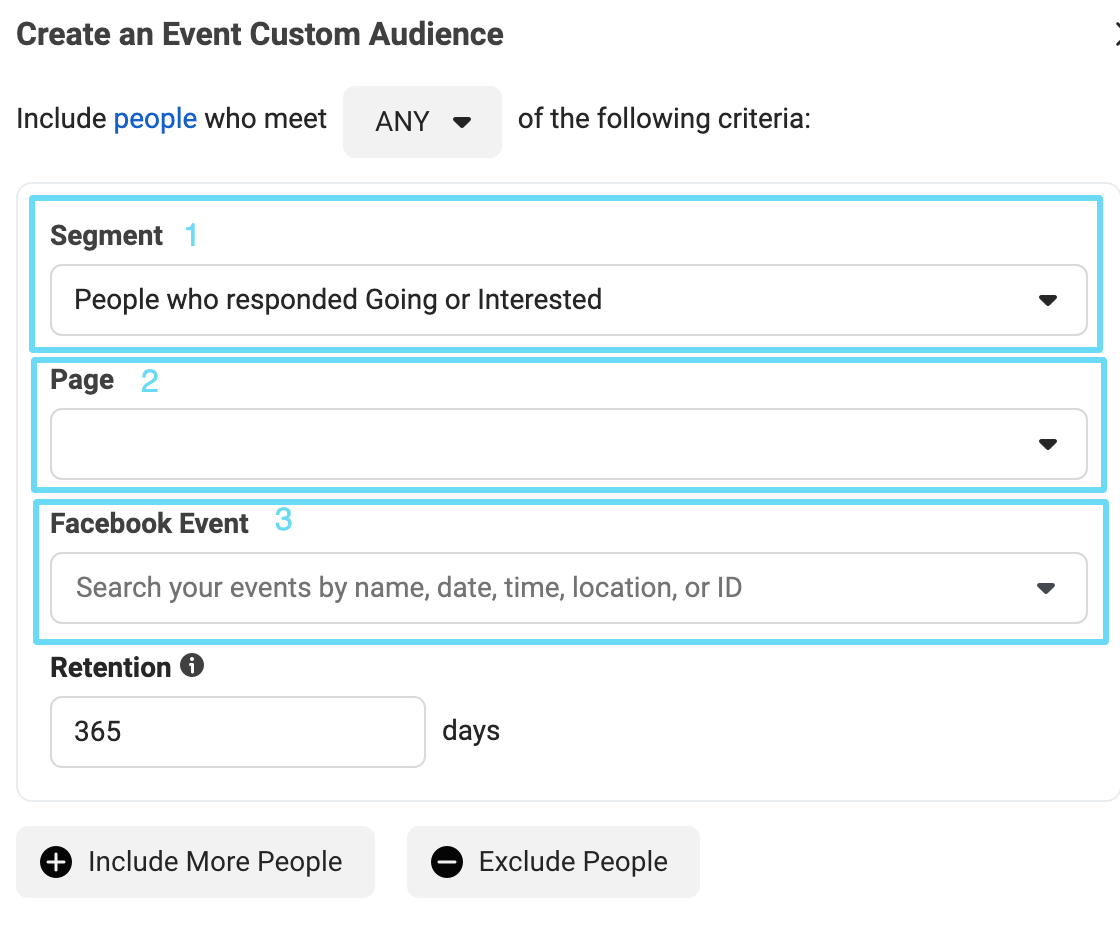
- Segment: Decide what actions taken on your events you want to target.
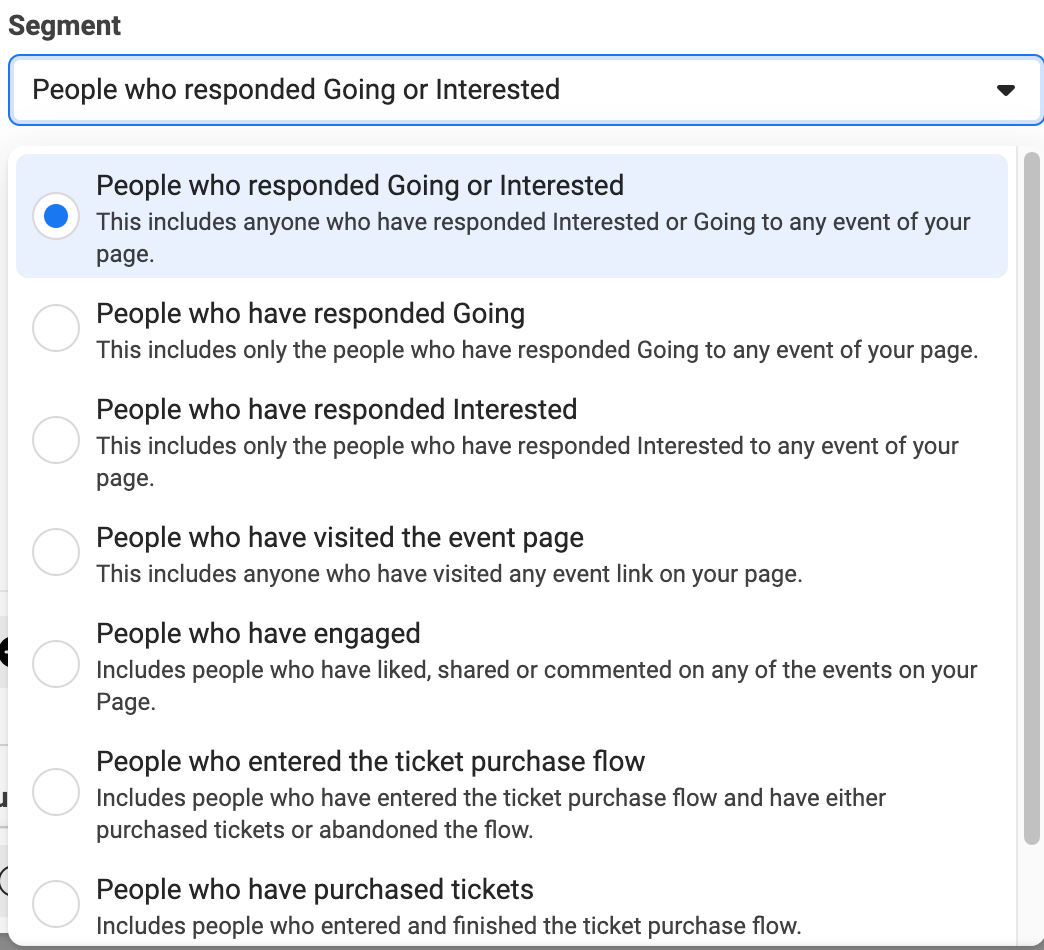
- Page: Select the Facebook page your event is associated with.
- Facebook Event: Find the event whose engagement you want to add to this audience.
Perfect. Now you’re working to maximize returns from your event engagement.
Facebook page
If you can retarget engagement on your Instagram account, then you can definitely also target engagement on your Facebook page. Both are equally important and capture different demographics, so it’s worth testing them both.
This is perhaps the most highly used option for retargeting on-Facebook engagement; at KlientBoost, we make use of these audiences a lot.
Inevitably, people who engaged with our page or our posts on Facebook are more active there. They might be more receptive to an ad for the same business they’ve seen the Facebook page of.
To get started, select “Facebook page” in custom audience creation.
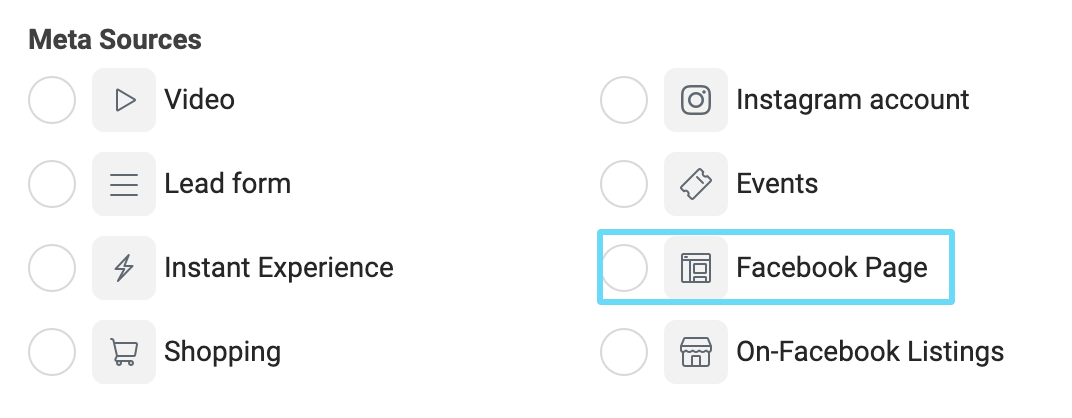
There are only 2 new setup elements to keep your eyes on here:
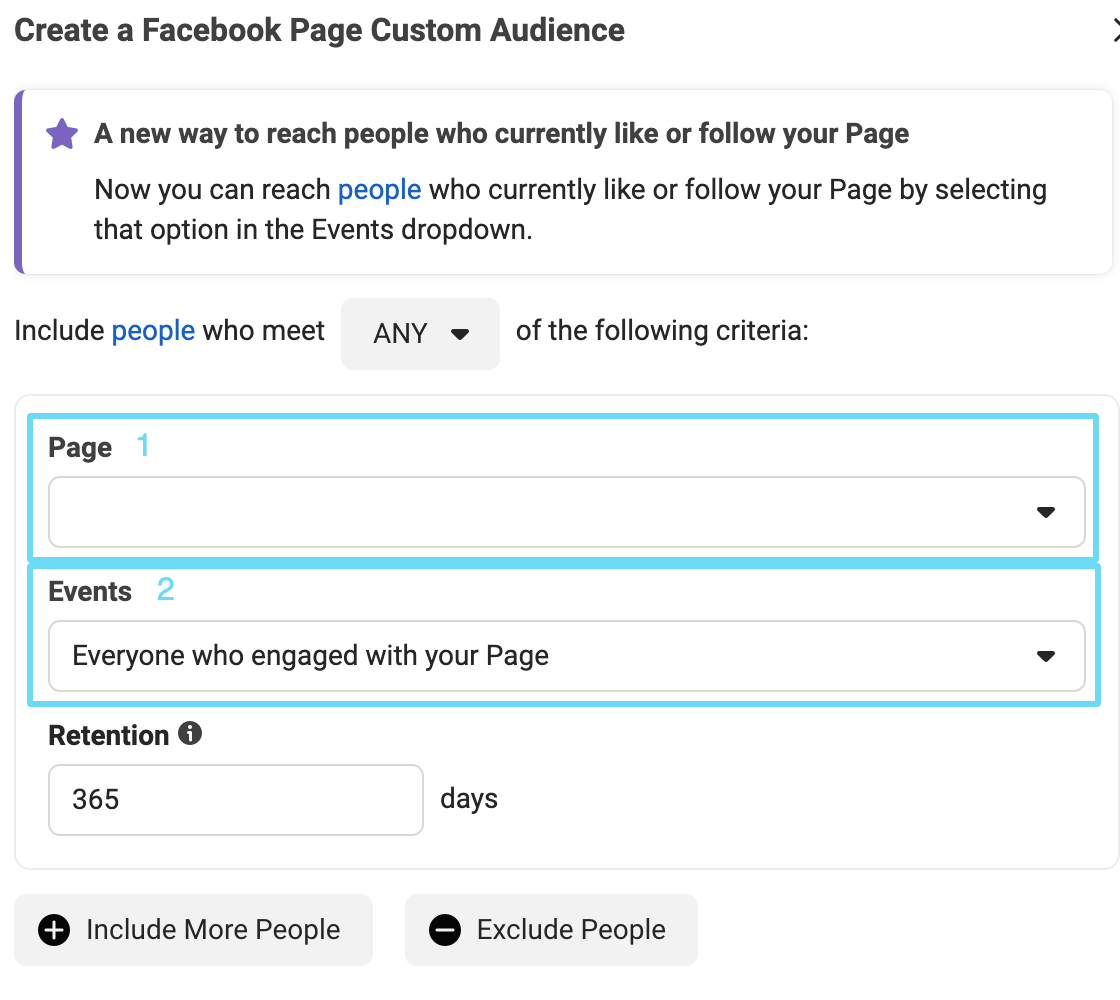
- Page: Select the Facebook page from which you want to add engagers to this audience.
- Events: Select the actions people would need to take on your Facebook page to be added to this audience.
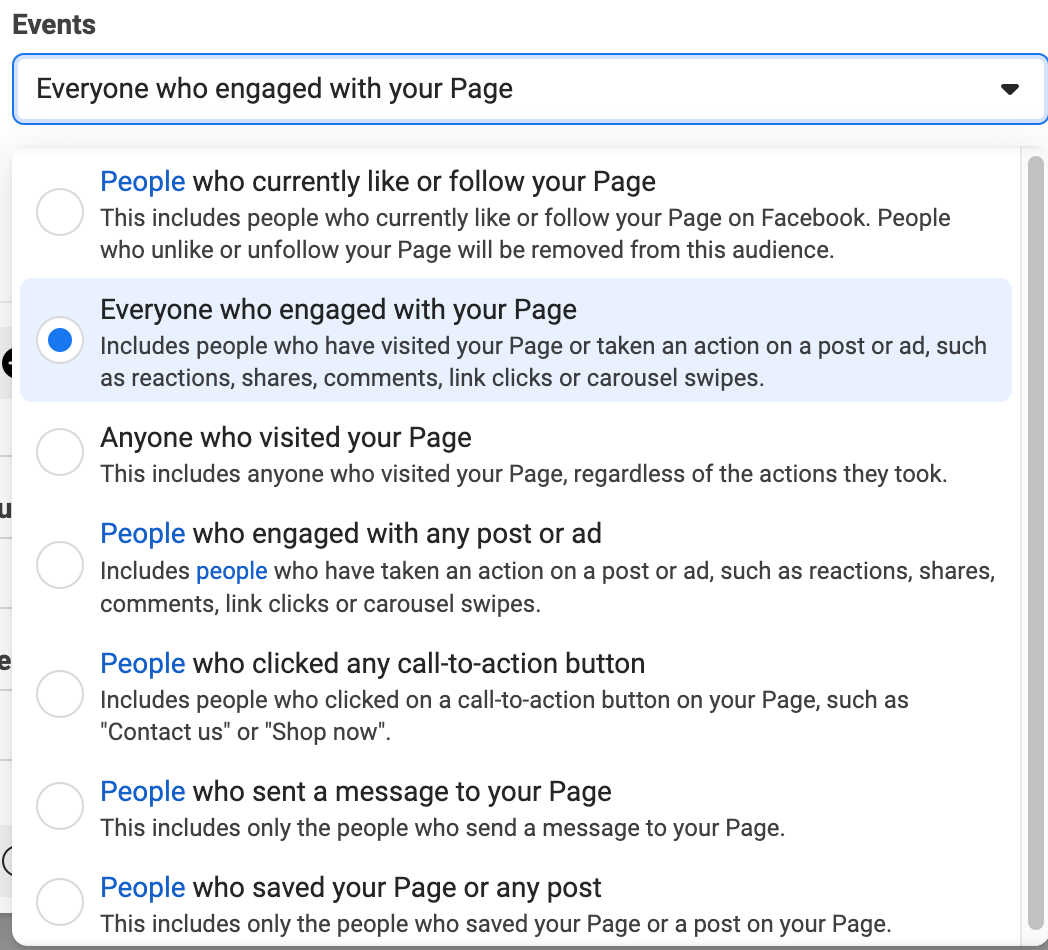
That’s all she wrote. Now get out there and start re-engaging those page participants.
On-Facebook listings
Last but not least, if you commonly run Facebook Marketplace listings, you have a golden opportunity to retarget people who have interacted with those listings.
To get this audience going, select “On-Facebook Listings” from custom audience creation.
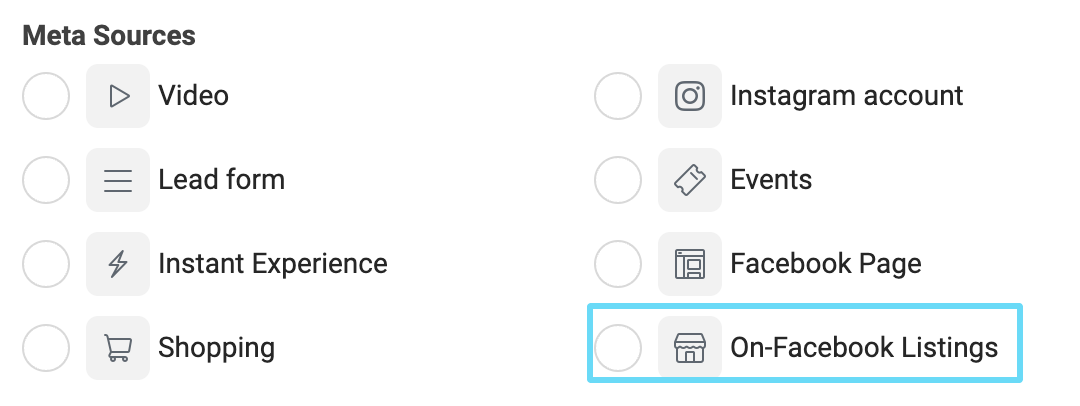
The rest of the setup here is fairly simple–there are just 2 unique elements to look at:
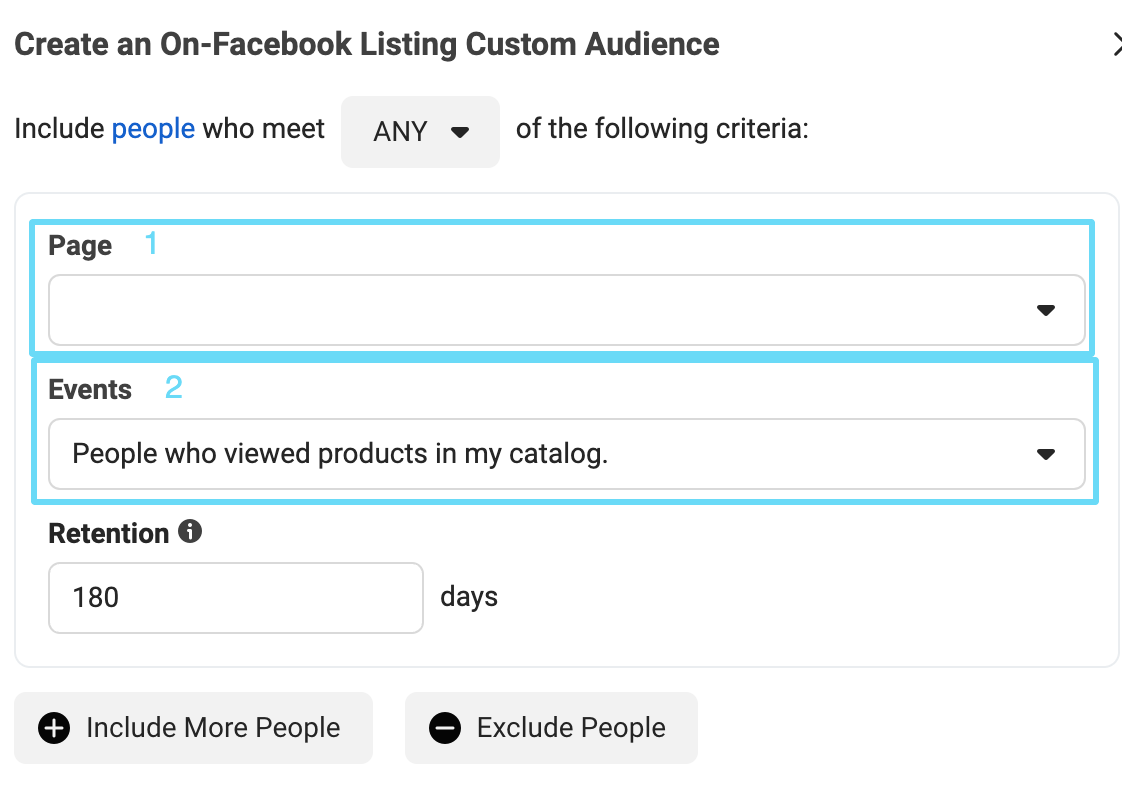
- Page: Select the Facebook page your listings are associated with.
- Events: Select what actions people would need to take with your on-Facebook listings to be added to your audience.
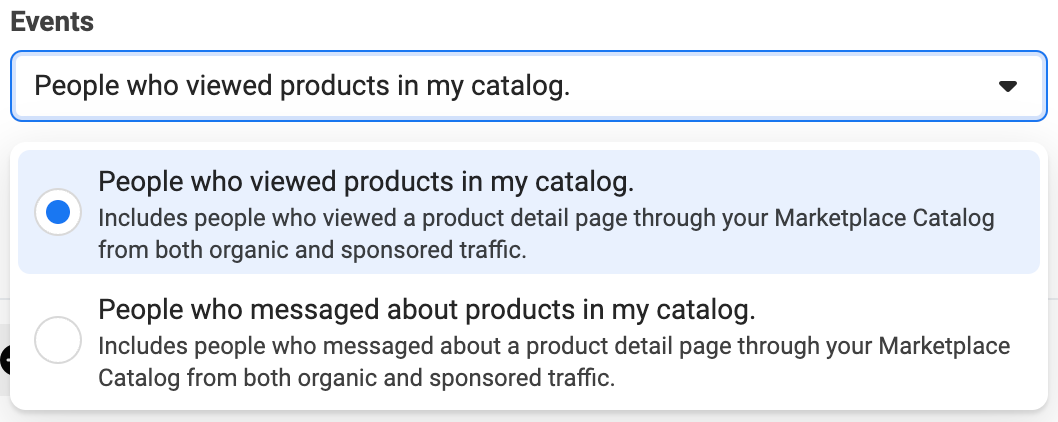
You’re now ready to start retargeting people who’ve checked out your listings.
8 must-try Facebook custom audience ideas
Alright, so now you’ve gotten up close and personal with every different type of custom audience you can set up.
Heck, you might have already built some audiences out and started using them, which means you’re well on your way to better account performance.
At the beginning of this blog, we promised you some awesome custom audience ideas to kickstart your success, and now is the moment of truth.
Hold on to your hats, folks–you’re about to be blown away.
1. Custom audience of all past website visitors within a 30-day window
This is an easy one to start with, but it’s nevertheless essential to your account’s wellbeing.
If you could only create one Facebook custom audience for retargeting with Facebook ads, this would be it.
The people who have visited your website might have different intents and expectations, but they’re a great place to start retargeting.
For example, implementing a basic retargeting strategy helped our client, Nurture Life, increase their conversion rate by 346% and their conversion volume by 158%.
Additionally, one of our clients saw the lowest CPA of any of their campaigns from a newly implemented retargeting audience:

Target your past website visitors with a Facebook offer that reminds them of your brand and presents a warmer offer. Because they’re already familiar with you or your products on some level, you can now turn up the temperature on the offer you present them with.
If you feel not all website visitors would be receptive to your most bottom-of-funnel offer, then nurture them with lighter offers like a whitepaper download.
We typically have found, however, that audiences retargeting all website visitors do quite well at scoring bottom-of-funnel conversions, even though we don’t know the level of intent of all those users.
Benefits of targeting all website visitors
- You’re reminding people of the benefits of your brand
- You’re nurturing interest in your products with a warmer offer and increasing the amount of people who convert
- You’re intervening in the “comparison-shopping stage” by staying top-of-mind as people look around
Tips for targeting all website visitors
- Use a shorter time frame (30-60 days) to keep your offer relevant
- Exclude audiences who have already completed your most valuable conversion (purchase, lead, etc.) unless your product is typically purchased again in a very short time
2. Custom audience of people who visit specific high-intent landing pages
On average, 26% of customers will return to a website because of retargeting ads.
So, when the landing page that a potential customer has visited hints at there being a higher-intent prospect, you want to take measures to ensure that at least 26% of those people come back to reconsider you.
A high-intent page is typically a sign-up page, a buy page, an item detail page, or a pricing page.
Someone who has visited your pricing page, for example, has likely thought about buying, to the point where they’ve looked into how your product fits within their budget. Maybe they’re comparing your pricing with competitor pricing at this point.
Someone who has visited an item’s detail page is taking notes, looking closer, and probably assessing pricing, too.
Because these people have done more than browse on the surface level, now is your chance to present them with a hot offer.
If they’ve visited your pricing page, and you have a discount running for 25% off their first 3 months, then you’d be wise to retarget that offer to pricing page snoopers. That could very well be the only thing standing between them choosing your product or someone else’s.
To give you a great example of the difference between general retargeting and high-intent page retargeting, take a look at this:

We discovered through testing that people who visited the “plans” page on this client’s site were closer to a purchase than both our general retargeting and free trial retargeting audiences.
Retargeting to that specific webpage produced a volume that nearly matched our all visitors retargeting audience, but with a CPA that was 140.5% lower.
Benefits of targeting high-intent landing page visitors
- They show higher interest in a particular product or use case, and tend to be more valuable prospects
- If you have different products or services, you can retarget product or service specific offers to people who have viewed them
- You’re able to intervene when someone is much closer to a decision to sway them toward your brand
Tips for targeting high-intent landing page visitors
- Use an offer specific to the landing page, or specific to the visitor’s spot in the buying cycle (e.g., if they’ve visited a pricing page, show them a pricing offer)
- Use a clear call-to-action for the next step you want people to take (like “sign up,” “buy now,” etc.)
- Let your ad frequency reach higher than usual (up to 15 points)
- Have an arsenal of different offers to test
- Exclude people who’ve already converted
3. Custom audience of your blog readers for higher engagement
Here’s a story about how you can lose your potential fans and blog readers:
People google a question about a specific problem that you know how to solve.
They find one of your blog articles and read it through.
After reading your post, they still don’t have the answer they wanted.
They click their browser’s “close tab” button and never return to your blog again.
Naturally, you’d like to avoid this series of events and turn all blog visitors into BFFs (Best Fans Forever). And by masterfully retargeting your blog readers, you can.
Benefits of paying for Facebook content distribution
You might ask: “Why should I pay for content distribution on Facebook if I can simply publish a post and just reach my followers?”
It’s a fair question, but Facebook has been actively working to keep branded content out of organic News Feed results for quite a while now.
In July 2016, Facebook announced that they’re making the News Feed more friend-and family-centric, reducing the reach of branded content significantly.
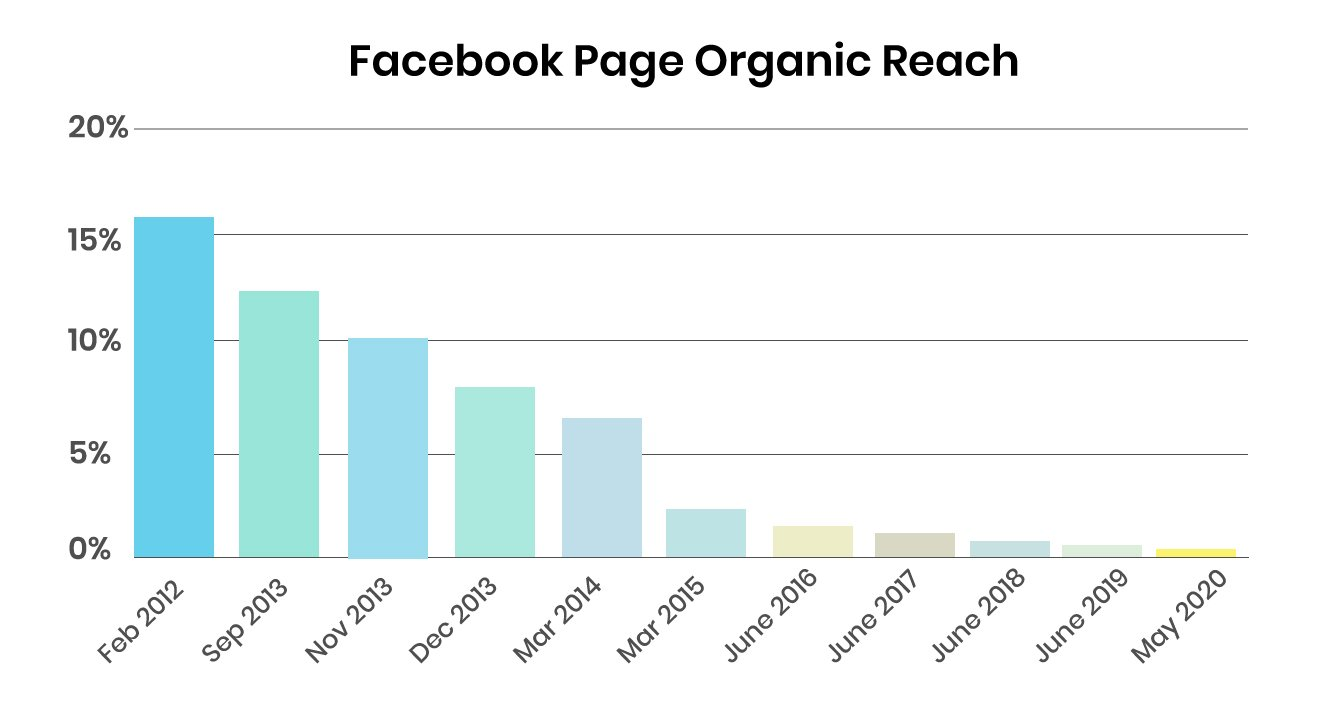
Facebook doubled down on this policy with an update in 2018 that lowers the priority of Pages content to make users’ News Feeds “more about connecting with people and less about consuming media in isolation.”
So while I won’t say you can’t reach Facebook users organically, you should know that it’s an uphill battle that might not generate effective results. Which is why you should consider paid content promotion.
Make yourself known: Paid content promotion
If you want your blog readers to find your shared articles and content on Facebook, you need to boost posts and promote your blog content with ads.
The easiest way to retarget your blog readers is by creating a large custom audience of all the people who have visited your blog’s domain. To recap, when creating this custom audience, you would use the “Website” option under “Your Sources,” and choose to retarget specific pages only.
If your blog covers a wide range of topics, you can create different Facebook custom audiences based on specific blog topics.
If 30% of your blog content is about cats in space, for example, create a Facebook custom audience of blog readers who have read your cats in space articles. Then, retarget them with your most popular and most valuable blog post relevant to cats in space.
Benefits of targeting your blog visitors
- You’re keeping your blog readers engaged by promoting more great content they can access
- You’re using Facebook boosted posts or ad campaigns to amplify your blog’s reach
- You’re improving your click-through rates because your readers are already interested in your content or the content topic you’re advertising
- Bringing people back to more of your content is a way to nurture potential future leads or purchases (people who are really familiar with your content will trust your brand) 😉
Tips for targeting your blog visitors
- Create multiple audiences of people interested in particular topics so you can tailor the blog content you advertise to them
- Use Facebook as a testing tool for finding perfect content headlines
- Exclude the people who have already read/downloaded specific content
- If you want this audience to nurture toward leads (not benefit existing leads or clients), then exclude your converters
Here’s an extra idea-within-an-idea: Once people have clicked through and spent time in your blog, you can create a new retargeting audience based on how long they spent on the blog.
Remember that “visitors by time spent” retargeting event type we talked about earlier? Target the 5th percentile (those who spent the longest on your blog) and click “specify landing pages” to target people who spent the longest time on your blog’s domain or specific blog pages.
Consider giving this audience an offer that increases “the ask” of what you’re wanting them to do.
This could be a “gated” eBook offer that requires them to give you their email address to download it.
Boom, email marketing opportunities incoming.
As a matter of fact, one of our clients used this tactic (targeting the 25th percentile of time spent on blog pages) and saw a 123% Increase in conversions, 14% increase in clicks, 15% decrease in CPC, and 56% decrease in CPA.
4. Custom audience of your converters
Up until now, we’ve been hitting you over the head with the “exclude your converters/buyers/etc. from your retargeting” memo repeatedly. That’s because, in most cases, that’s the right thing to do. It’s also one of the best ways you can prevent wasting budget.
However, there are actually instances where retargeting your converters or existing customers is a good idea.
Shocker, we know.
Obviously, this doesn’t work for every business. If you’re a lead gen business with one product and buying that product online is the finish line for you, you’re not going to want to show more ads to people who already bought.
But let’s look into some circumstances this can work for.
eCommerce post-conversion retargeting idea: Cross-sell
I’ll start off with a simple example right out of the gate:
If you sell coffee and coffee products, and someone buys coffee beans from you, retarget them with a pour-over set, coffee filters, an electric kettle, etc.
You know your current customers have a product of yours that requires certain accoutrements. And you know you have said accoutrements. So why not capitalize on their interest and high intent by showing them your related wares with ads, and any discounts you have on them?
Lead generation post-conversion retargeting ideas: Nurture and upsell
Even though lead gen businesses are collecting leads, they still all have one goal in common: a sale.
We wouldn’t necessarily want to retarget people who have already bought, unless you have other products to upsell to them that build upon the product they bought.
For example, say that you have a large audience of people who bought a basic version of your software for $25/month. But you have a more advanced version of that software with more features that your current basic version users will likely need as their businesses grow, and right now the advanced version is only $10/mo more expensive.
You can absolutely retarget those customers with an offer pushing your more advanced software. You’d do so by retargeting converters in the Facebook event you made to track purchases of the basic software.
If you don’t have different tiers of your product, or additional products and services to cross-sell to customers, you can still retarget top-of-funnel converters to nurture your leads.
For example, let’s say you’re running ads promoting a “download a free whitepaper” offer, gated or ungated. You can retarget people who downloaded your whitepaper, and then show them a middle-of-funnel offer to bump them down the funnel, like signing up for your free webinar.
Benefits of post-conversion targeting
- You’re capitalizing on super high-intent prospects who already liked your brand and product enough to convert
- You’re gaining additional revenue from customers who already purchased and may still be in the “spending frame of mind”
- Or, you’re encouraging leads down to the bottom of the funnel faster
Tips for post-conversion targeting
- Promote related items to the one the person already converted on
- Keep your audience lookback window short (30 days or less if your conversion traffic is high enough to support it) to make sure you’re getting in front of people who are still hot prospects
- Combine Facebook ads with other marketing channels for greater impact
5. Custom audience of your newsletter subscribers
There are very few brands left on Earth that don’t use email marketing to some extent. After all, you need to get important messages to your customers somehow.
Newsletter subscribers break down into two groups: 1) active readers engaging with your emails and 2) inactive users that haven’t opened your emails in months.
If you’ve got lots of inactive subscribers, here’s some good news:
MailChimp’s analysis of 60 million eCommerce purchases and 40 million email addresses from retailers showed that one inactive subscriber is still worth 32% of an active subscriber.
Further, inactive email subscribers who don’t engage with your brand as much as active fans are still 26% more likely to make a follow-up purchase than non-subscribers.
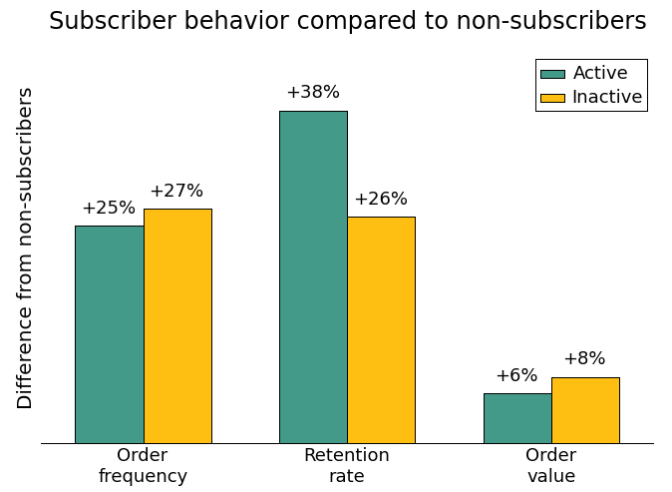
Active readers always lose interest for a reason. Maybe they don’t perceive value in your newsletters anymore. Maybe you send them too often. Or maybe they just don’t have time to read.
By using Facebook custom audiences, you can set up retargeting campaigns to renew valuable customer relationships with various newsletter subscriber segments.
You can do this by uploading your email subscribers as a customer list, which will allow you to segment your lists based on the activity level of your subscribers.
Or, if you want to retarget all subscribers regardless of activity level, you can begin (if you’re not already) collecting newsletter subscriptions as a conversion event, and retarget people who converted on that event once you have enough of them.
Pro tip: Newsletter subscriptions are a great top-to-middle-of-funnel ask to present to colder audiences before you hit them with a bigger ask. So, it’s a good idea to track these.
Benefits of retargeting newsletter subscribers
- You’re nurturing people on your email list who have already shown high interest in your newsletter content to turn them into leads down the line
- You can revive people on your email list who haven’t opened your newsletter in a while by reminding them of your brand in a different channel
Tips for retargeting newsletter subscribers
- Resist the temptation to bombard all of your newsletter subscribers with a request to buy something. Active readers might be receptive to that, but with people who don’t or rarely open your newsletters, use a less threatening offer (like a whitepaper or blog post) that shares valuable advice to bring them back through consistent nudges
- Segment newsletter subscribers to create highly targeted ad campaigns
6. Custom audience of free trial and freemium users
Do you sell products that have a free trial period?
According to Totango, you can only expect about 15-20% of your free trial users to actually become paying customers.
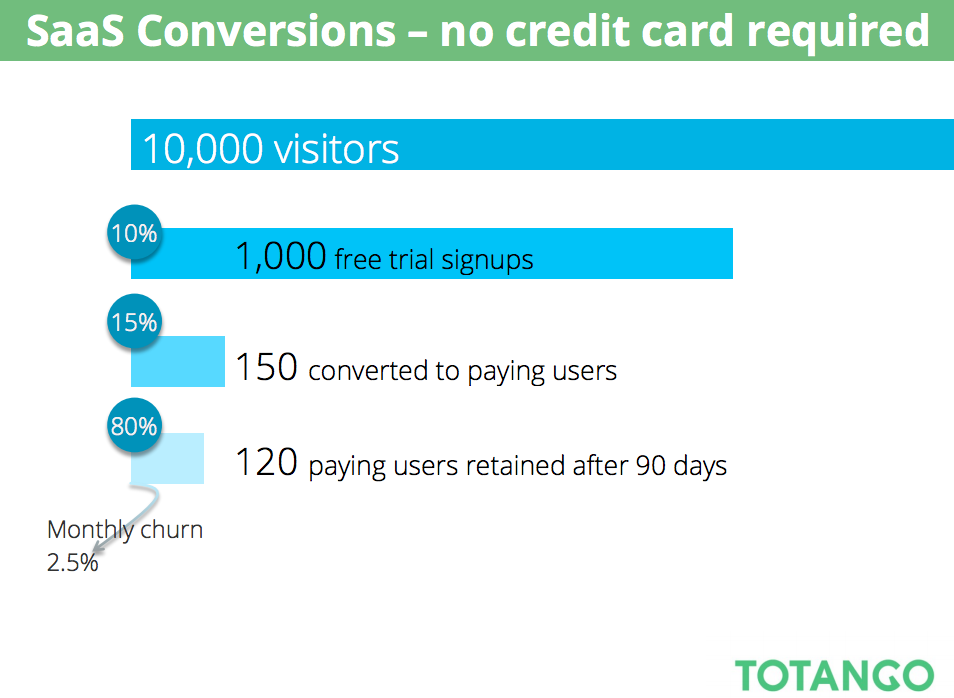
Even if you’re best-in-class, that means you’re only getting 200 paying users from every 1,000 free trial opt-ins.

Retargeting your trial users is 10x more effective than retargeting all website visitors. It’s not an opportunity you should ignore.
If that’s not enough to convince you, just look at the difference in CPA between retargeting all website visitors and retargeting free trial users for one of our clients:

During a free trial, your goal is to get users to engage with your product and to see how it can benefit them. You want to give them enough value so they eventually want to sign up for the paid version of your product.
Benefits of targeting free trial users
- You can share facts and numbers about your product’s benefits
- You can use convincing testimonials to overcome people’s objections
- You’re capitalizing on the high intent of someone who’s currently getting familiar with your product and deciding if it’s right to buy
Tips for targeting free trial users
- Share case studies and testimonials of similar users (if you have video ad testimonials, now’s the time to break those out)
- Share guides to getting started
- Promote a discount offer on the paid version of the product, if you have one
- Promote premium features included only in the paid version
- Have a stellar landing page that matches your ad
7. Custom audience of people who engaged with your Facebook page
If you regularly share branded content and videos on Facebook, you (hopefully) get tons of engagement in the form of views, likes, shares, and follows.
Unfortunately, many marketers have no idea what to do with these engagement metrics. But we’ve visited this topic already–and now you do know everything you can do with them.
I also mentioned that retargeting people who engaged with your business in some way on Facebook (whether that’s a page like, a follow, etc.) was one of the most popular Facebook source targeting tactics we use at KlientBoost, so it makes sense that this would be one of our ideas for you.
Showing ads to people who’ve engaged with your Facebook page is a form of retargeting (though we like to call it re-engagement). It tends to be around the middle of the funnel intent-wise.
To give you an example of some of the wonders this type of targeting has worked for us, one of our clients saw a 78% lower CPA from targeting engagers compared to the account’s control CPA (which turned out to be a really nice-looking $14 CPA).

And, the cherry on top, another of our clients saw a 155% increase in conversions, 32% Decrease in CPA, and a 13% decrease in CPC by starting a re-engagement campaign.
So, why aren’t you targeting your Facebook engagers yet?
Benefits of targeting Facebook page engagers
- You’re getting in front of an audience that’s already familiar with your brand and has shown enough intent to check you out on Facebook
- You’re retargeting those people with ads on the same platform they engaged with your business on
- Intent is warmer here than an average prospecting audience
Tips for targeting Facebook page engagers
- Choose an offer with a bigger ask, such as signing up for a webinar or gated content that requires contact info (but split test your most threatening offer, too, to see how it performs with this level of intent; we’ve had success with both)
- Try video ads along with image ads to see what performs best
- Keep an eye on frequency and switch up your message as needed so your ads don’t get too stale with people in this audience
8. Custom audience of cart abandoners
For many eCommerce businesses, retargeting people who ditch their carts and leave items behind is essential.
We’ve probably all seen email marketing strategies coming after us with the “you forgot something” message when we’ve abandoned our carts. Arguably, a better way to get in front of cart abandoners is by serving them ads.
Check out this example from one of our clients, who scored the lowest CPA of any of their retargeting audiences through a cart abandoners audience:

Whether they left their cart unpurchased because they’re waiting for their next paycheck, because they read a review that made them unsure, or simply because they forgot, retargeting them is the easiest way to push their high intent to the finish line.
You can retarget cart abandoners by setting up an “Add to Cart” event via your Facebook pixel (and hopefully you’re already tracking a “Purchase” event).
Then, use a “Website” custom audience to target people who have completed the “Add to Cart” event, but haven’t converted on your “Purchase” event.
Benefits of targeting cart abandoners
- You can remind people of your products and bring them back to finish what they started
- You’re targeting high-intent users who have already thought about purchasing in some capacity and are really close to doing so
Tips for targeting cart abandoners
- Test showing cart abandoners a different or new offer, like a 10% off discount or free shipping, to give them a reason to finish their purchase now
- Exclude purchasers from your “Add to Cart” audience to make sure you’re only targeting abandoners
- Test testimonial or case study ads if your product is relatively unknown and you suspect cart abandoners may be hesitant for that reason. You can make your ad a testimonial and new offer hybrid, too, to gain trust and incentivize checkout in one go
Try out your new arsenal of audiences
At the end of the day, using custom audiences is in your and Facebook’s best interest. NOBODY wants to see ads all day for something that’s not relevant to them.
Gone are the days of blasting a message out to everybody, wasting your precious dollars. If you’re willing to spend the time, you can customize your audience to get your message to the exact people that want to hear it, exactly when they should be hearing it.
At this point, you’ve learned all you can about how to use Facebook custom audiences, and how you can benefit from them. You’ve also jotted down our 8 awesome ideas and put them in your testing queue.
You’re ready to take on the world of Facebook, one custom audience at a time.
Now, remember when we said not to neglect your prospecting audiences? If you’re ready to build your prospecting skills and target top-of-funnel audiences that rake in the dough, start with our post on interest targeting.